What Is Cost Per Click (CPC)?
Cost per click (CPC) refers to how much an advertiser pays each time a user clicks on a paid ad.
CPC falls under pay-per-click (PPC) marketing, a form of online advertising where you pay for your site to appear on websites and in search results.
You’ve probably seen Google paid search ads, which appear above organic search results:
The price you pay for ads can influence your campaign’s success.
In this article, we’ll cover how to calculate and optimize your CPC to save money on your advertising campaigns.
Let’s get started.
How CPC Works
Paying attention to your CPC tells you how successful your search advertising campaigns are.
And if you’re overpaying or underpaying on any of your campaigns.
To show up on relevant search engine results pages (SERPs), you need to bid on target keywords.
The amount you bid, among other things, determines where your ad will appear on the results page. Which affects the number of clicks you get.
The most common tool for running these kinds of ad campaigns is Google Ads.
In your account, you can create specific campaigns, set up “ad groups” (i.e., sets of related ads), write ad copy, and place bids for particular keywords.
Let’s first cover how to calculate your cost per click.
How to Calculate Cost Per Click
Cost per click is calculated by dividing the cost of an ad by the number of clicks it gets.
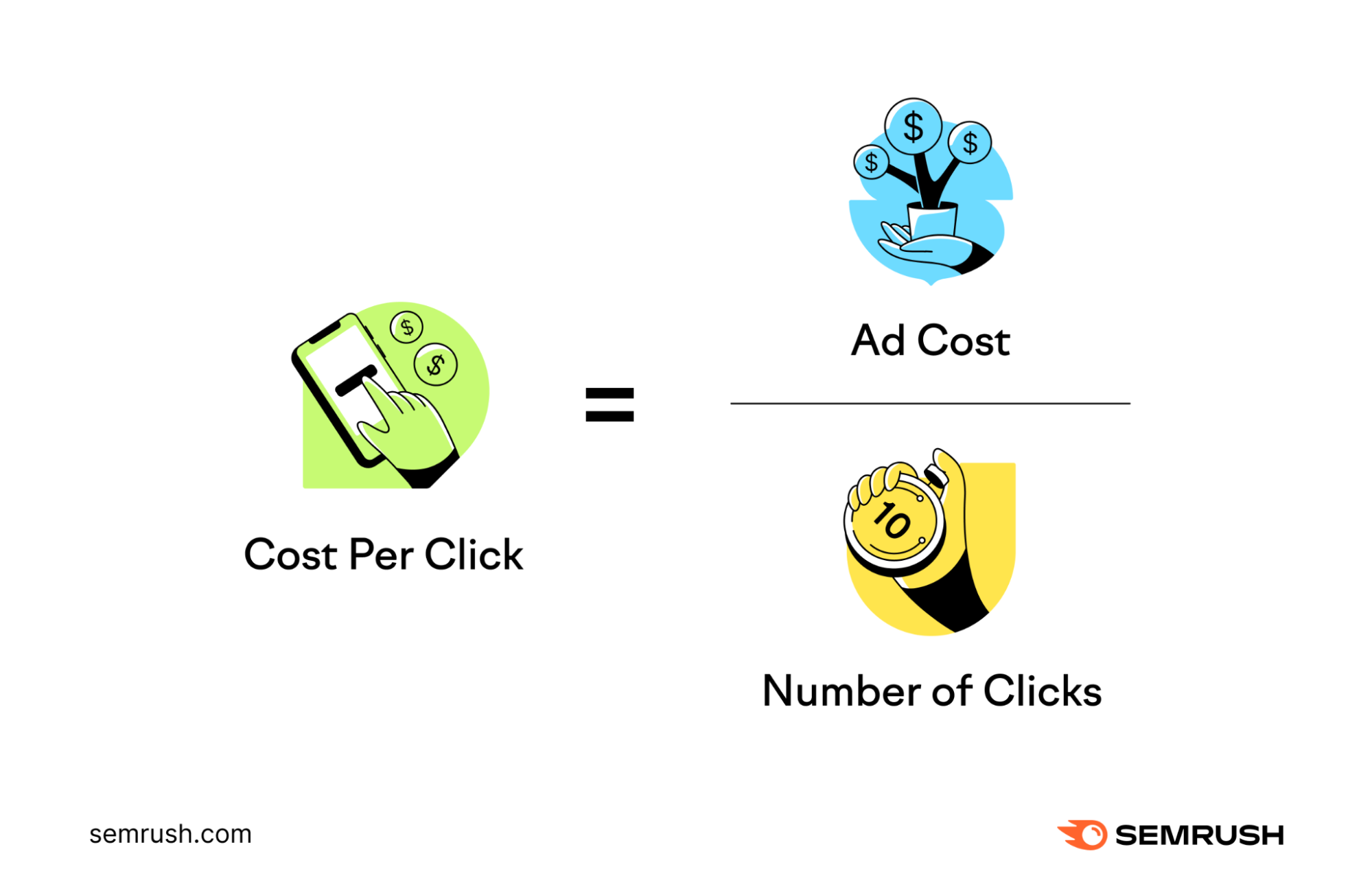
But you can analyze your ad strategy with more specific CPC metrics. Which include:
- Maximum cost per click
- Average cost per click
- Actual cost per click
- Manual cost per click
You can also choose specific bidding strategies depending on your specific goals.
Let’s start by covering some important CPC definitions.
What Is Maximum Cost Per Click?
Max CPC is the most you’re willing to pay per click. You set this in your Google Ads account.
When choosing your max CPC bid, choose the highest amount you think each click is worth. If someone clicks on your ad, it won’t cost you more than your max CPC.
A higher bid generally helps your ad show in a higher ad position on the page.
But you generally only need to pay the minimum amount as long as you beat your competitors.
What Is Average Cost Per Click?
Average cost per click is the total cost of all your clicks divided by the total number of clicks.
Let’s say your ad got two clicks: one click costs $1.00, and the other costs $3.00. Your total cost for both clicks is $4.00.
Divide $4.00 (your total cost) by 2 (your total number of clicks), and you get $2.00. So, in this case, your average CPC is $2.00.
What Is Actual Cost Per Click?
Your actual cost per click (actual CPC) is the amount you’re ultimately charged for a click.
Typically, you’ll pay much less than your maximum cost per click bid. This is you only need to pay the minimum required amount to beat competitors immediately below you.
(Provided your ad quality meets the Ad Rank threshold, or your ad’s ability to compete in an ad auction.)
Here are two of the most important factors Google considers when evaluating ads:
Ad Rank is the score that decides where your ad appears on the SERP (or if it appears at all). This score is determined by factors like bid amount, ad quality, competitiveness of an auction, and users’ search intent.
Quality Score lets you know how your ad compares to competitors’ CPC ads. A higher quality score (measured 1 to 10) means your ad and associated landing page are more helpful to users than your competitors’ ads.
Quality Score is determined by expected CTR (click-through rate), ad relevance, and landing page relevance.
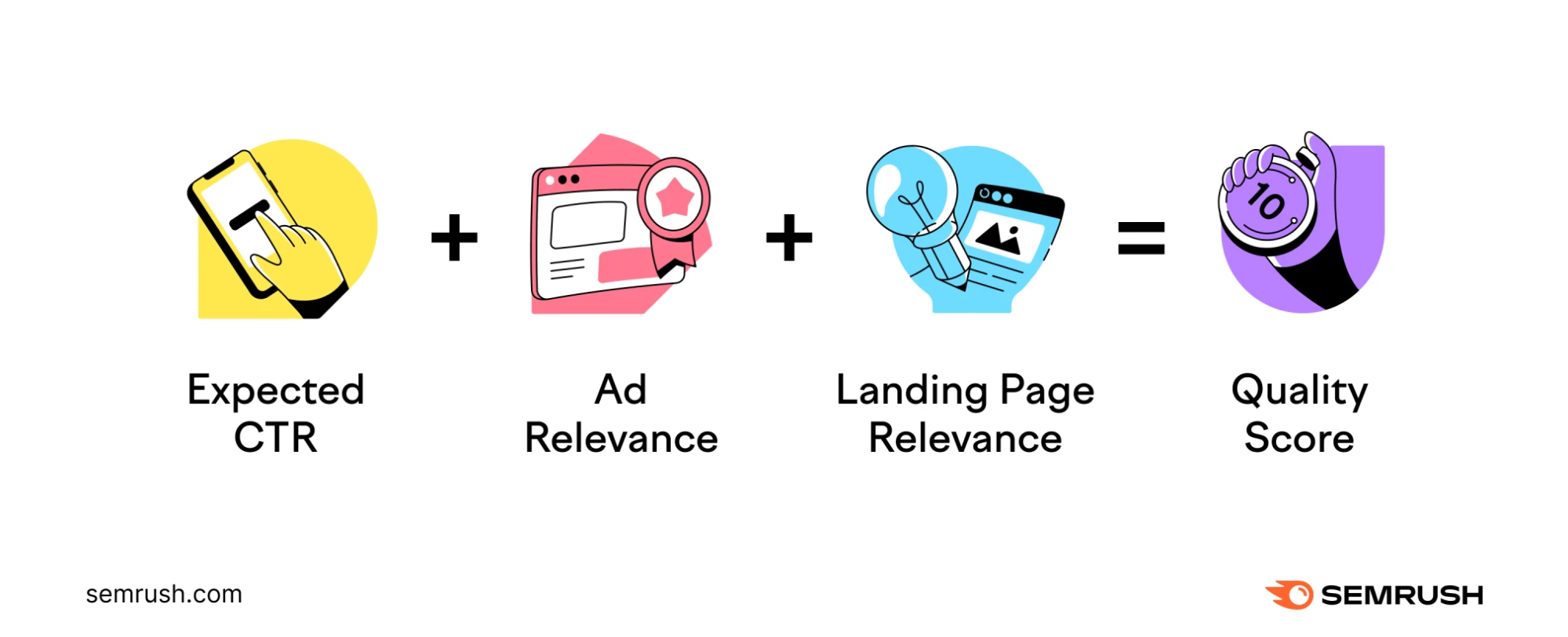
So if your ad meets the quality threshold and you’re bidding enough, you have a chance of showing up above competitors.
What Is Manual Cost Per Click?
Manual CPC bidding lets you set your maximum CPC for each ad you run and keyword you want to target.
Manual bidding is a great approach if you already know which keywords get you more clicks and conversions. Manually set a higher budget for those keywords.
What Is Enhanced Cost Per Click?
Enhanced CPC (ECPC) lets you make the most of your manual CPC strategy by automatically adjusting manual bids if a click seems more likely to lead to a sale or conversion.
ECPC is a combination of manual bidding and Smart Bidding. Which is a bidding strategy that uses machine learning to optimize for conversions and conversion value.
ECPC uses browser, location, and time of day to adjust bids to get the best chance of a conversion for the best price.
In short, ECPC helps you get the best value for a conversion.
What Is Automated Bidding?
Automated bidding is a strategy that allows Google to automatically set bids based on how likely your ad will result in a click or conversion.
For example, Google can automatically set a higher budget for competitive keywords if you’re close to the top three slots.
Different types of automated bidding strategies help increase clicks, visibility, and conversions.
How to Find a Keyword’s Cost Per Click
To run a PPC campaign, you need to know the average CPC for your keywords to set the right budget.
There are a few ways to find individual keywords’ average cost per click. Let’s start with Keyword Planner from Google Ads.
How to Find a Keyword’s Cost Per Click in Keyword Planner
The Google Keyword Planner was specifically designed to track and collect Google Ads data. And it’s free and easy to use.
Which is why it’s a great place to start your target keyword research.
First, head over to the Keyword Planner dashboard.
Then, sign in to your ad account. If you don’t have an ad account, hit the “Create account” button and follow the instructions from Google.
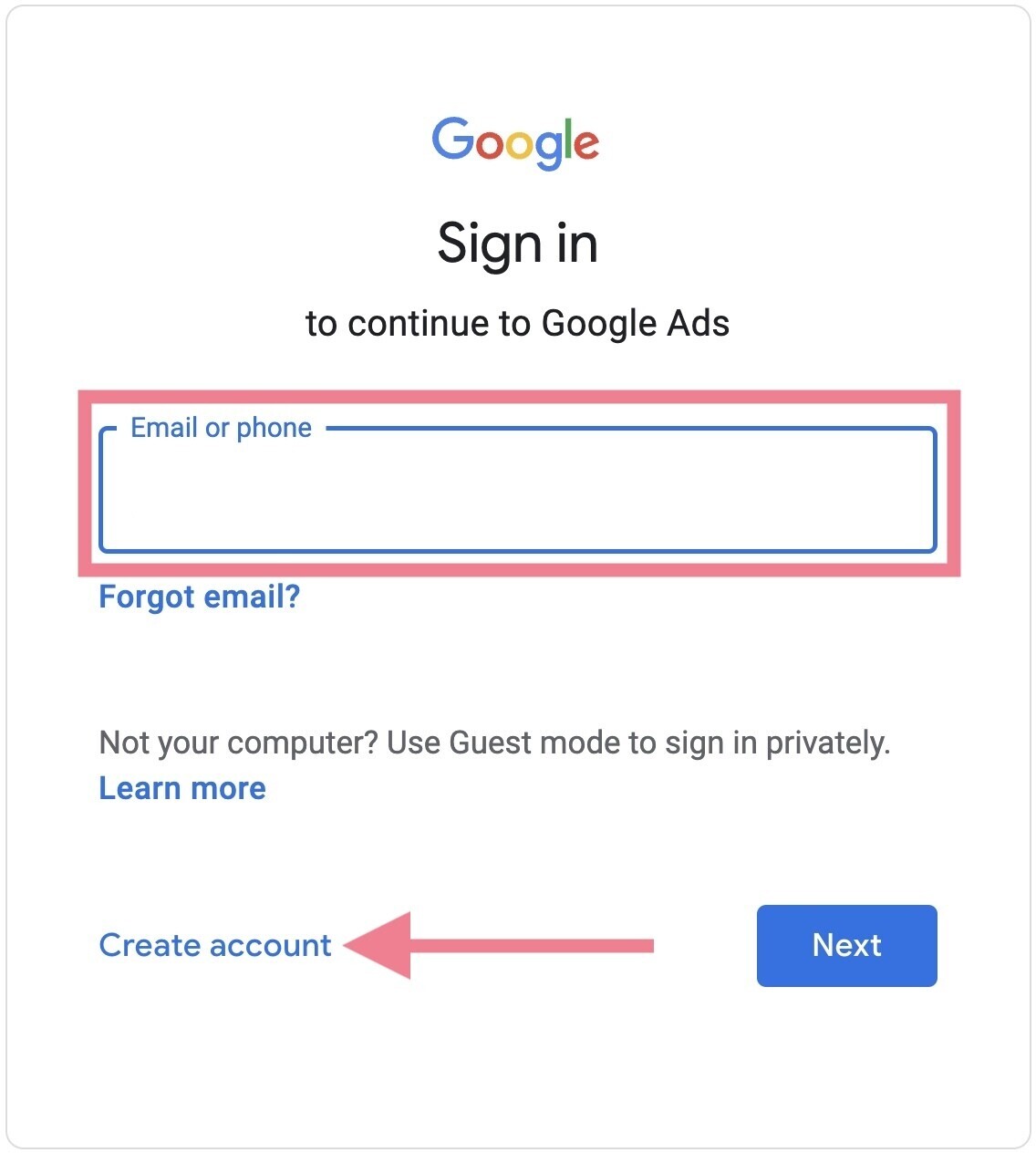
On the next page, click on the “Discover new keywords” tool.
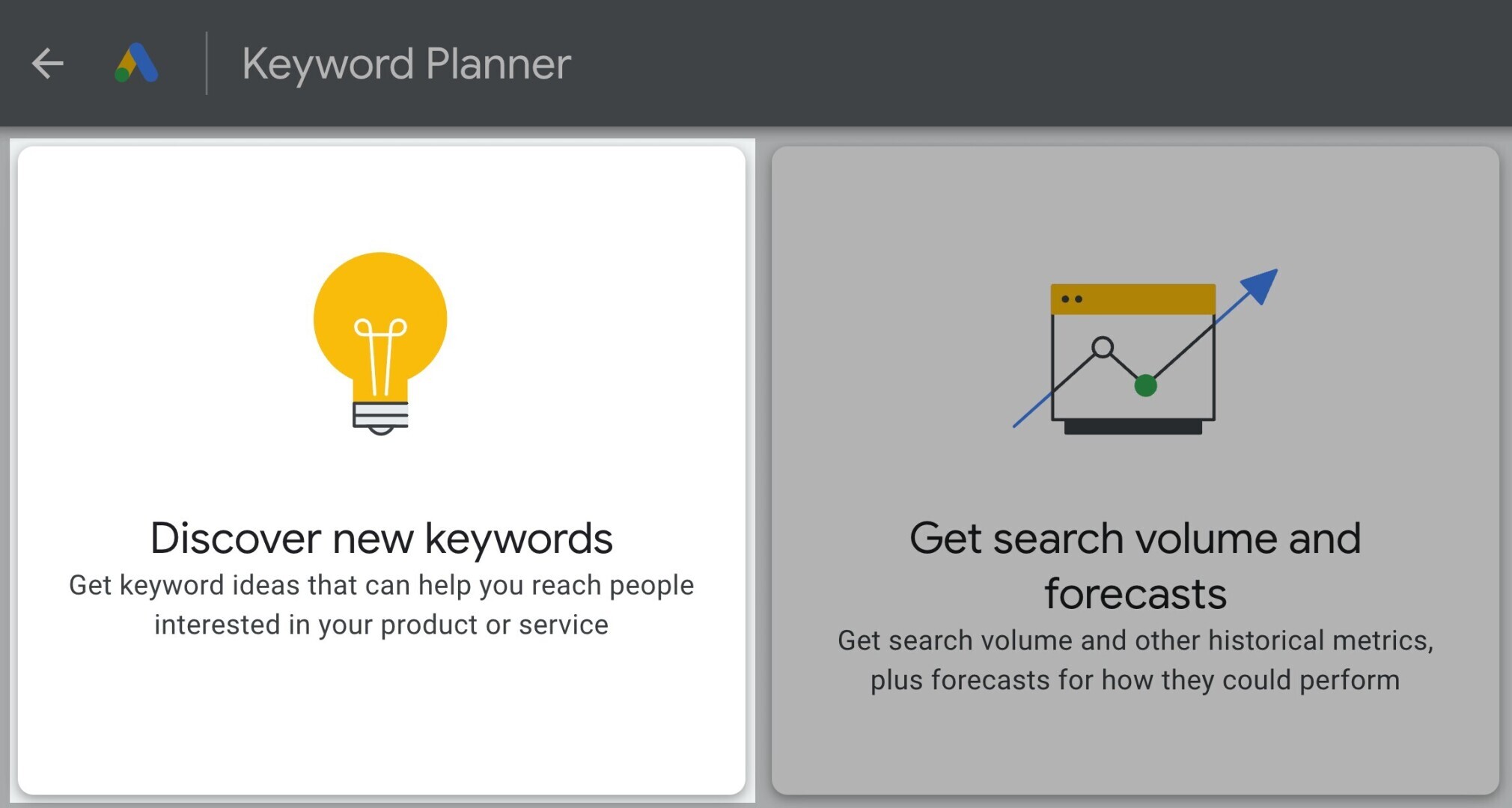
You’ll see a form with two options: “Start with keywords” or “Start with a website.”
Stay on the “Start with keywords” tab and enter the keywords you want to look up.
For example, we looked up “shoes,” “hiking shoes,” and “running shoes.”

After you hit the “Get results” button (or the enter key), you’ll land on the Keyword Results Page. Which presents keyword data in a table.
You’ll find each keyword’s CPC under two columns on the table’s right-hand side:
- Top of page bid (low range). The low end of how much advertisers have historically paid to get to the top of a results page.
- Top of page bid (high range). The high end of how much advertisers have historically paid to get to the top of a results page.
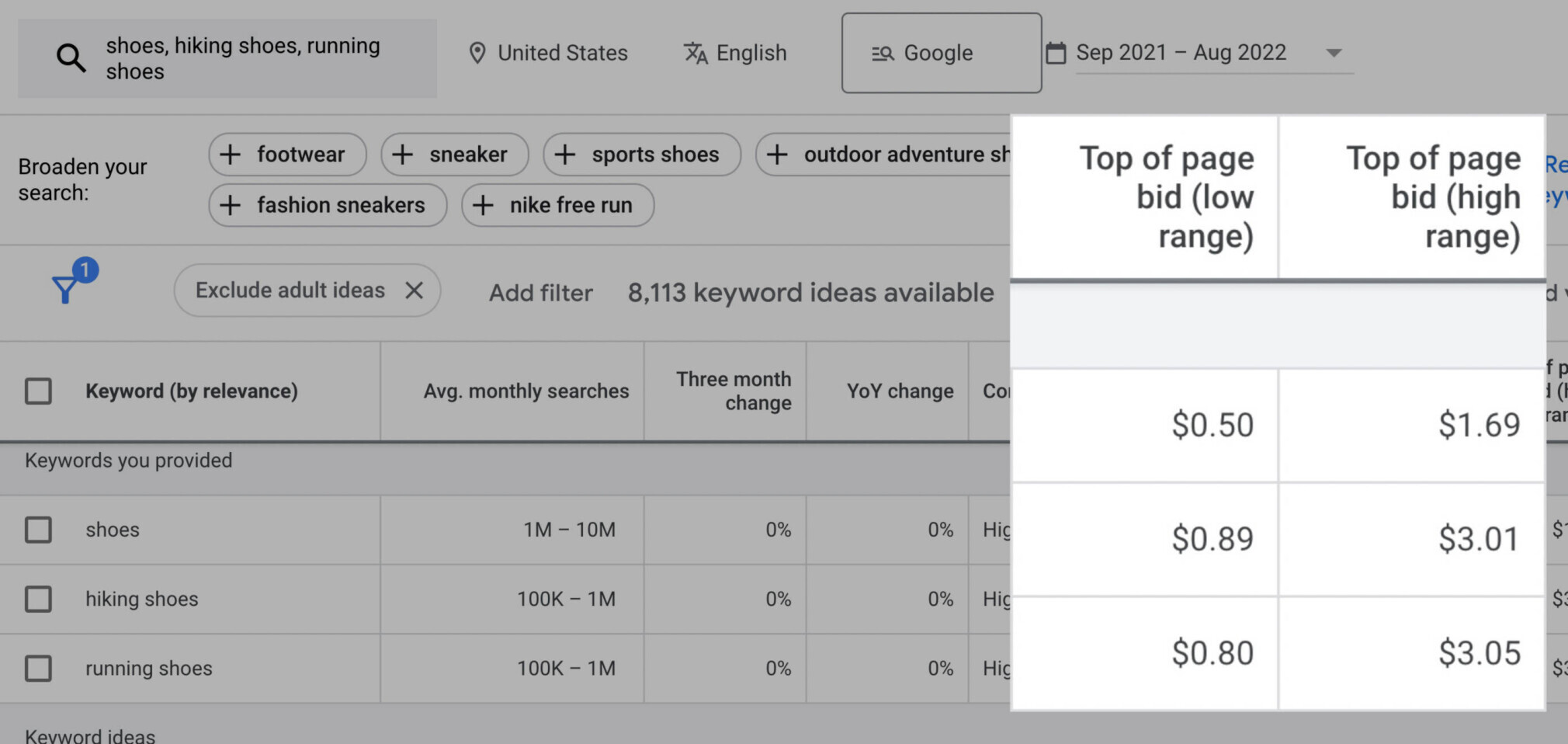
Use the CPC data Google provides to inform your targeting strategy.
How to Find a Keyword’s Cost Per Click in Semrush
You can also find a keyword’s average CPC in Semrush with the Keyword Magic Tool.
To start, enter your keyword and hit “Search.” For example, we looked up “hiking shoes.”
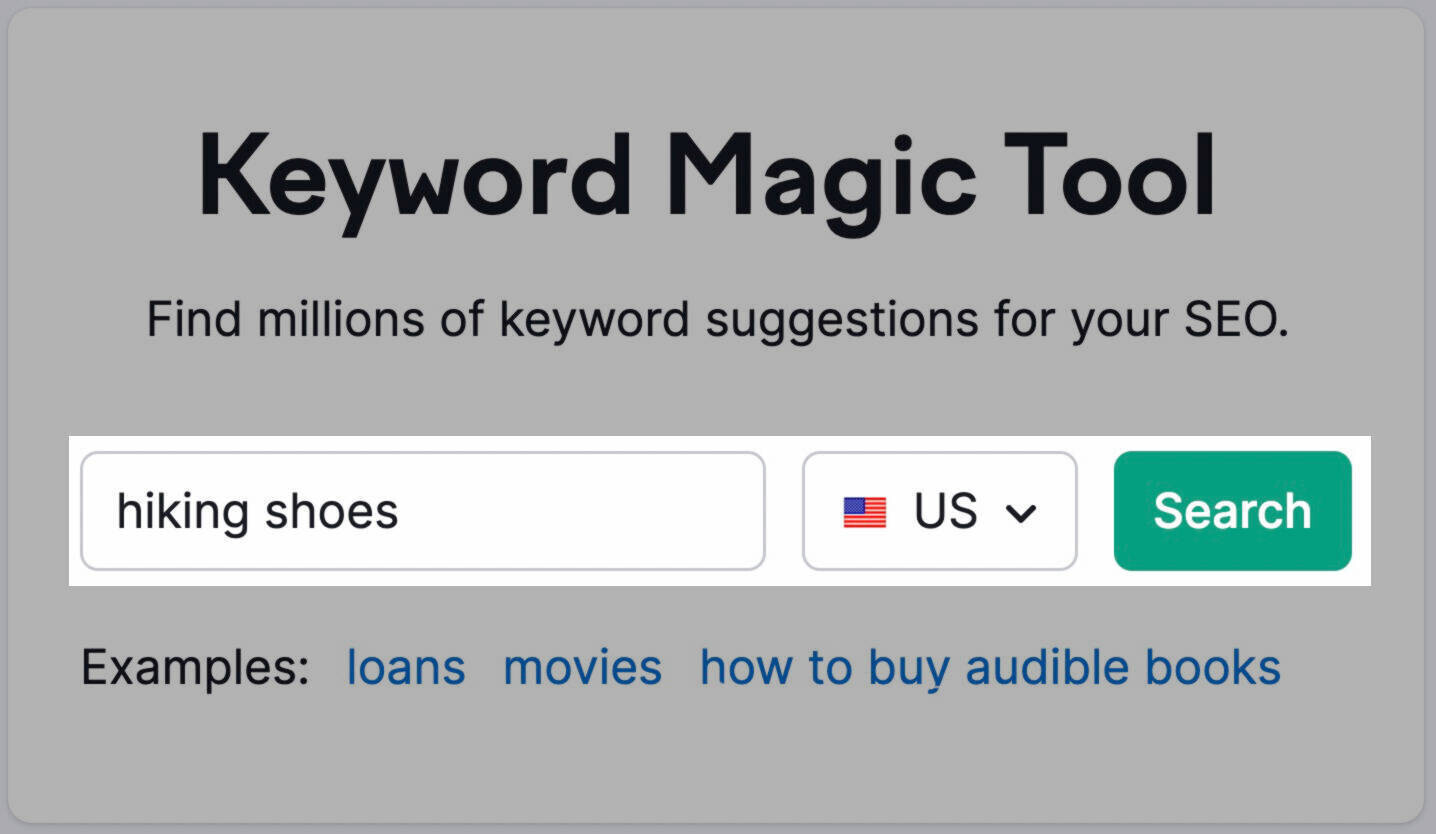
Similar to Google Keyword Planner, you’ll see a table with keyword data. And you’ll find your keyword’s CPC in the CPC column to the right.
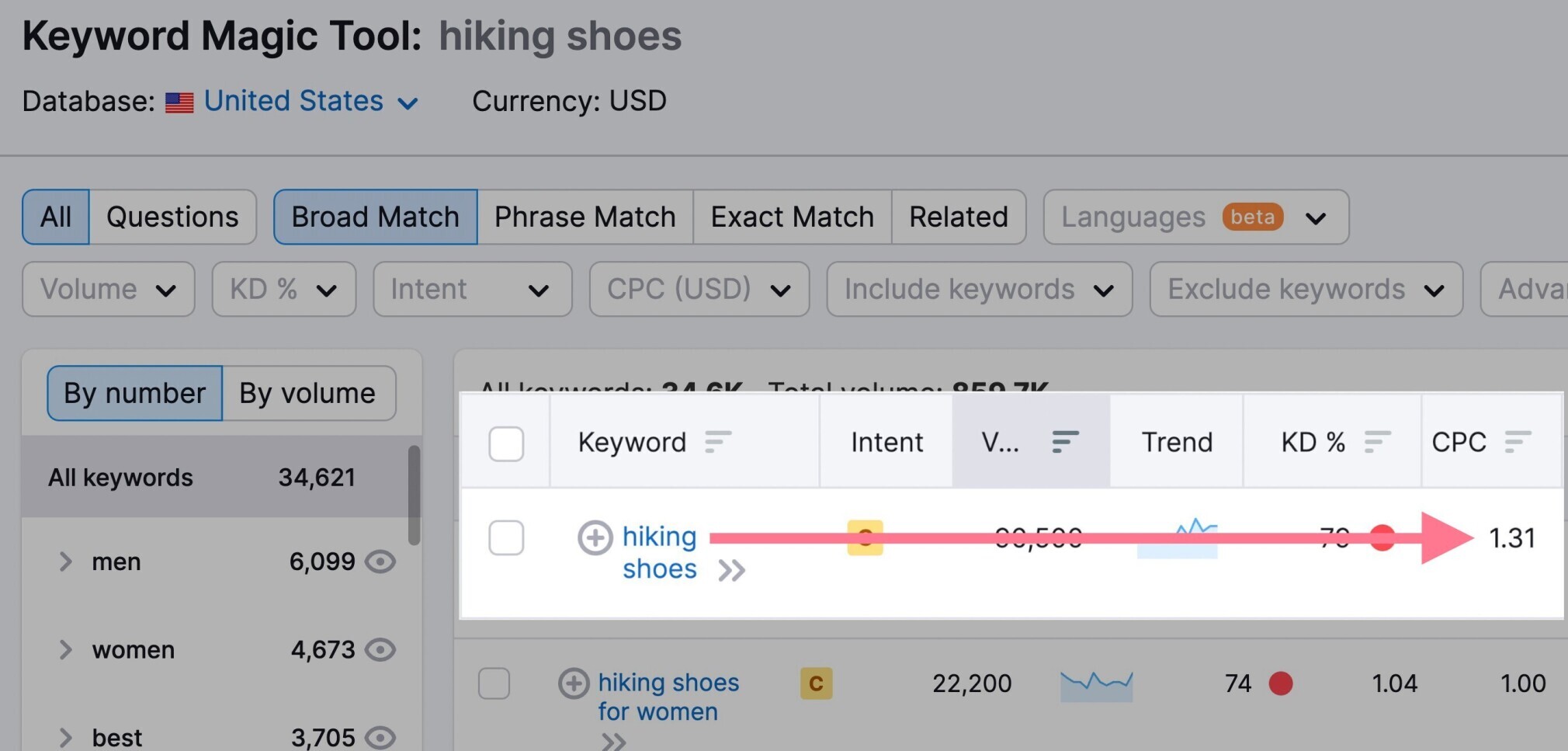
You’ll also get CPC data for other related keywords.
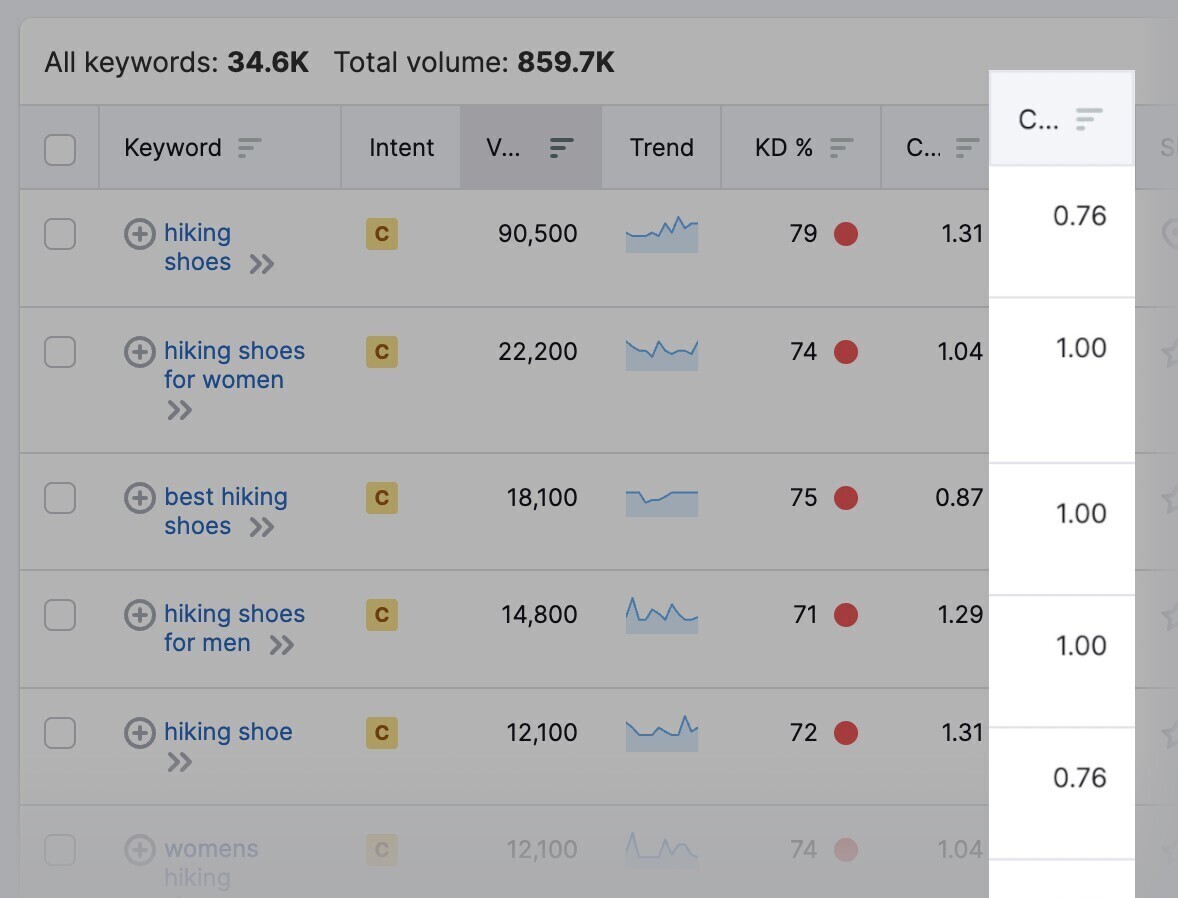
Use the table to learn more about your chosen keyword. And find more potential keywords based on CPC.
How to Find Your Competitors’ Target Ad Keywords
Get an idea of how much your competitors pay for clicks using the Advertising Research tool. That way, you can find out if you’re missing certain keyword opportunities.
Enter one of your competitors’ domains in the tool and click “Search.”

Once your results load, scroll down to “Paid Search Positions.” You’ll see keywords your competitor is bidding on, their ads’ positions, and the estimated average CPC for each keyword.
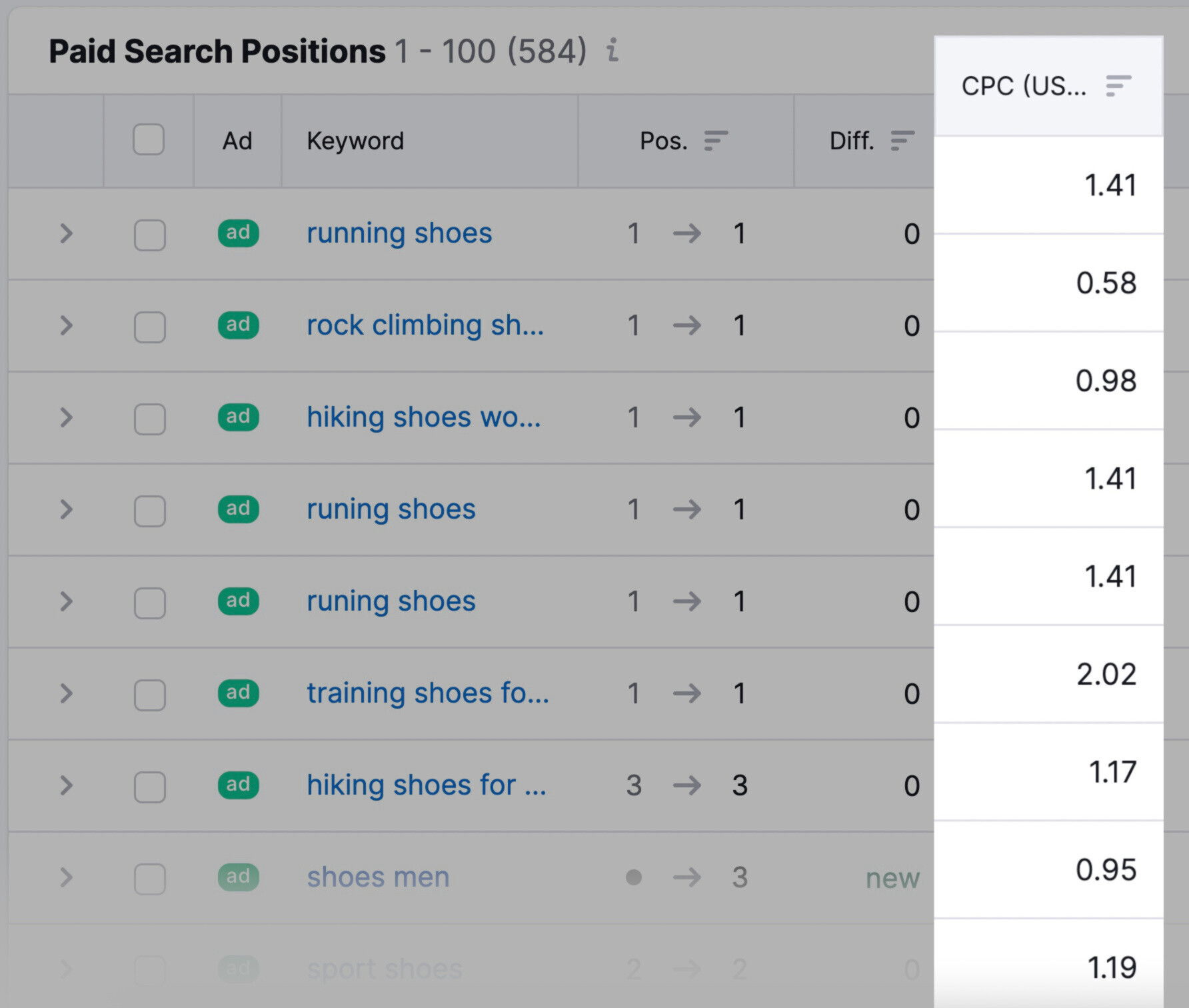
Compare their list of keywords with your own. And add keywords that seem like good opportunities to your list.
7 Tips to Optimize Cost Per Click for Your PPC Ads
Sometimes, your goal is to save money on PPC campaigns. And sometimes, you want to invest money (strategically) to reach as many customers as possible.
Here are some tips to help you make the most of your campaigns.
1. Improve Your Quality Score
Quality Score directly impacts your CPC. That’s because Google uses it to determine how relevant (and useful) your ad is compared to other ads competing for the same keyword.
You can increase your Quality Score by improving ad relevance, landing page experience, and CTR.
To find your Quality Score, click on the “Campaigns,” “Ad groups,” or “Keyword” tabs in the sidebar of Google Ads. Then, click on the “Columns” button.
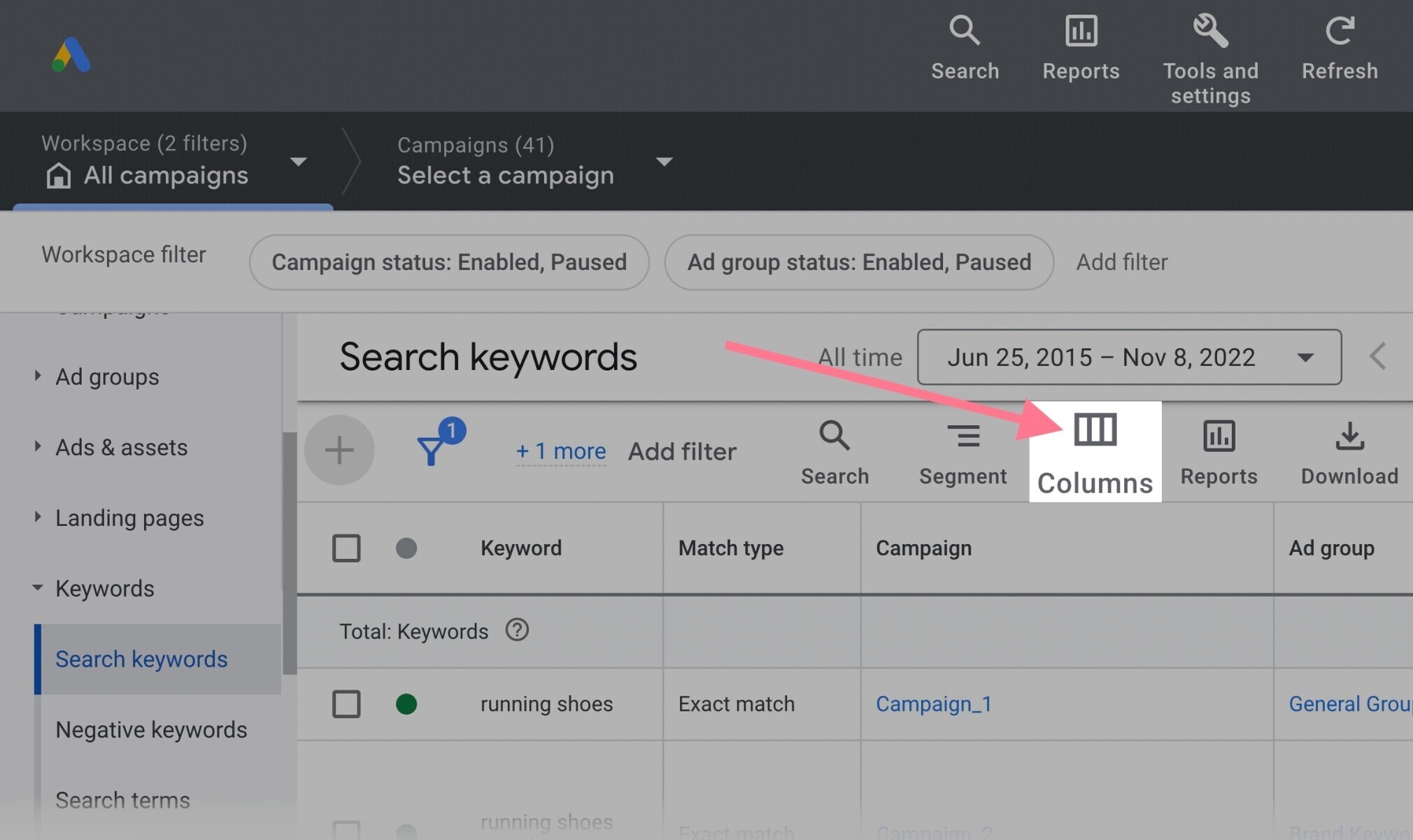
That opens a menu where you can modify the columns you want to see in your report.
Scroll through your options until you find “Quality Score” and hit the arrow to expand the field.
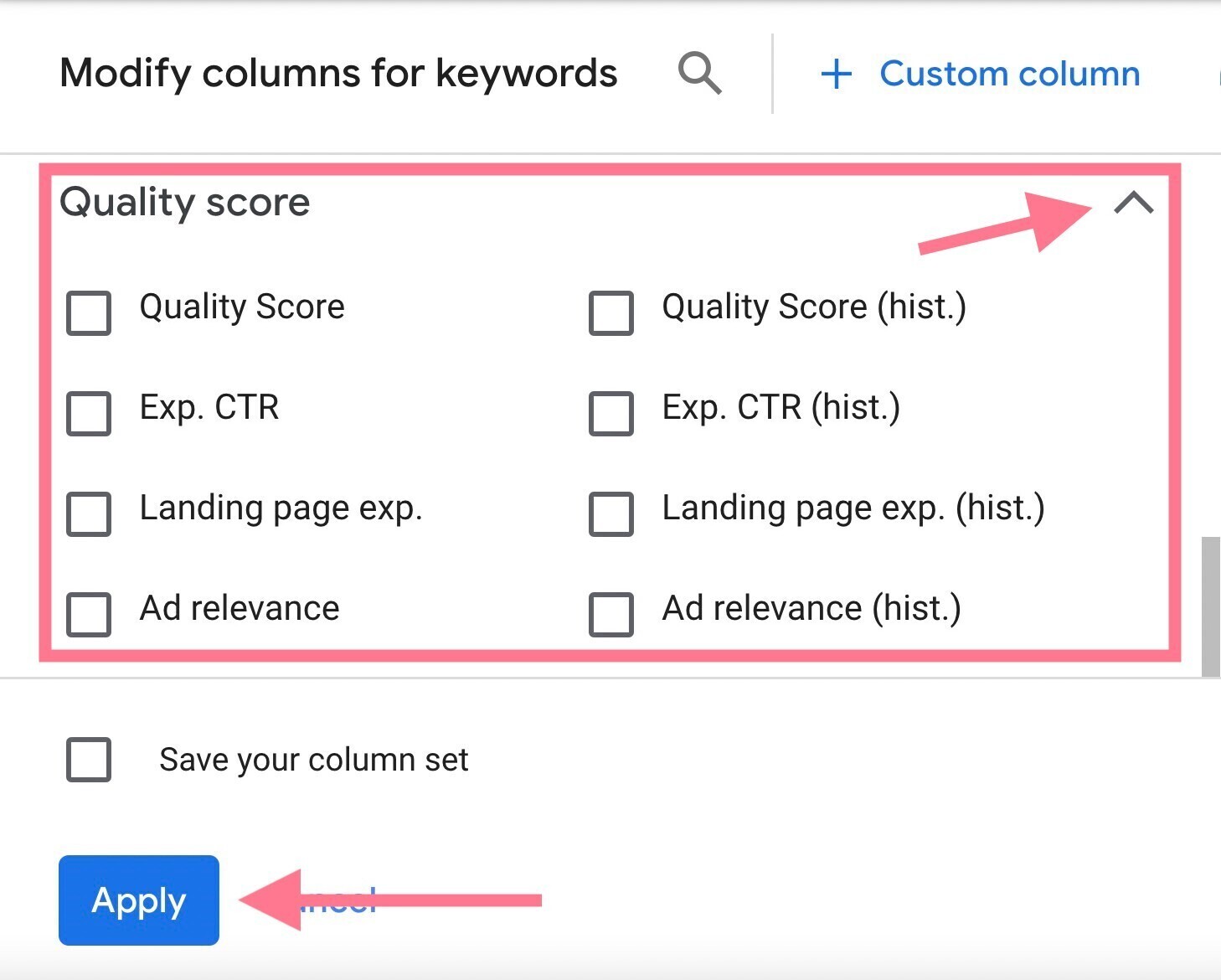
Choose which Quality Score metrics you’d like to see. Then hit “Apply.”
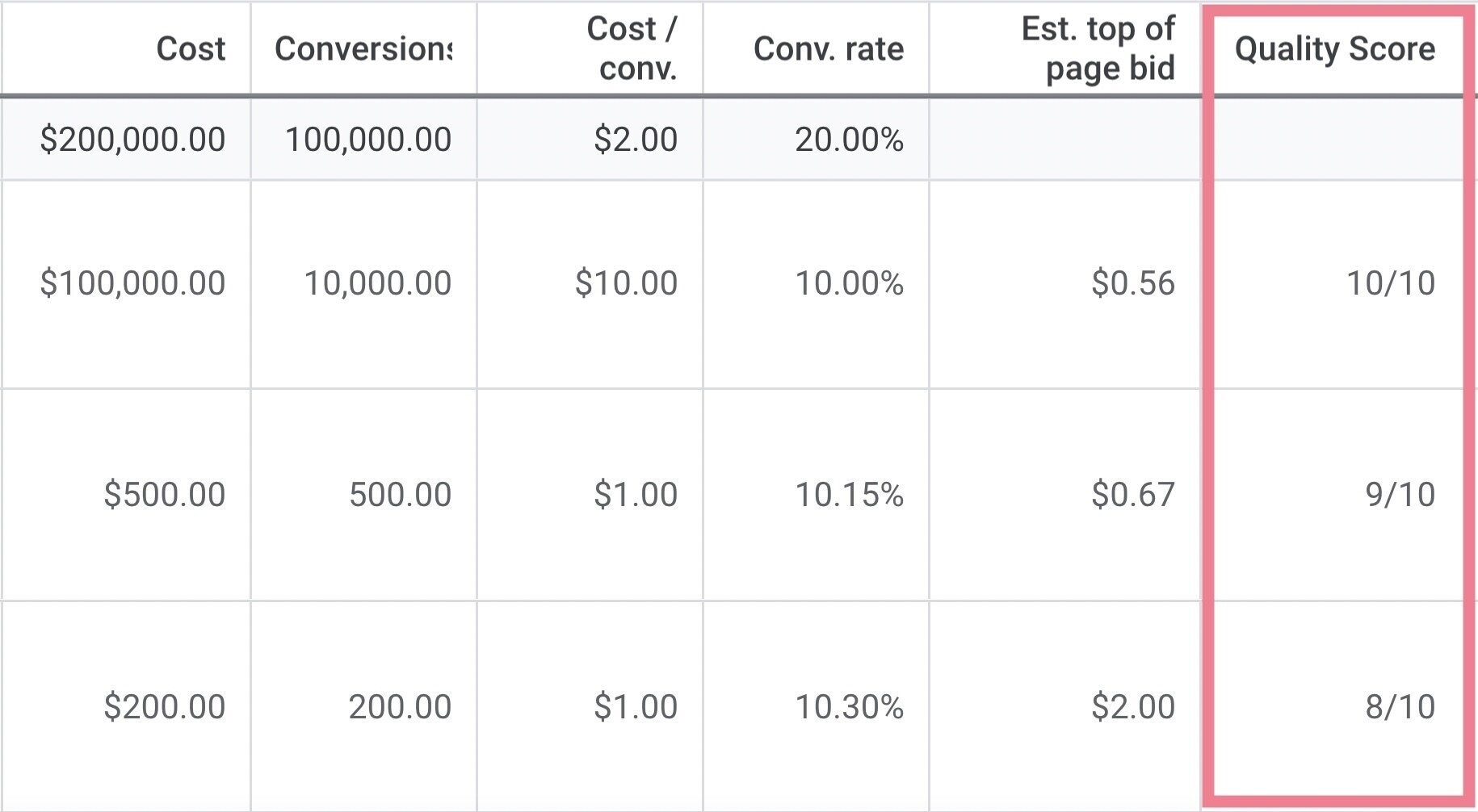
Now that you know your Quality Score, let’s look at how you can improve it.
Make Your Ads More Relevant
The more relevant your ad is, the more likely it will land in front of people interested in seeing it.
So avoid broad ad groups that cover multiple keyword groupings and focus on creating highly targeted ad groups.
For example, instead of having a single ad group that targets the broad keyword “running shoes,” split it up. Have an ad group for:
- Waterproof running shoes
- Running shoes for active women
- Running shoes with wide toe boxes
Each of those ad groups should target even more specific keywords.
Your “waterproof running shoes” ad group, for instance, should have keywords like “waterproof running shoes for winter” and “waterproof running shoes wide fit.”
You’ll likely create more ad groups (and more ads) this way. But the trade-off is that your ads will be more relevant to the keywords you’re bidding on, which can help improve your Quality Score.
Improve Your Landing Page
The quality of your landing page can have “a huge impact on your advertising effectiveness and budget,” according to Google.
Here are some Google-approved landing page best practices that can help improve your Quality Score:
- Be relevant. Visitors who click on your ad should be taken to a page related to what they searched for. If the page isn’t relevant, the user may immediately leave.
- Write clear copy. Write copy that clearly explains the purpose of your page and build trust with reviews or testimonials.
- Keep it simple. Don’t force users to click tons of links to find what they’re looking for. (And don’t forget to keep things mobile-friendly.)
- Provide good user experience. Make sure your landing page is accessible and consistent with your ad copy. You can also use Google’s PageSpeed Insights tool to check for page load issues.
Pro tip: Once you’ve put together a solid landing page, use SplitSignal to test different elements on your page. Like your CTAs (calls to action), headlines, and value propositions. That way, you can find out what your audience reacts to more.
Improve Your CTR
A high CTR determines whether your ad resonates with your audience—and improves your Quality Score.
Here are a few strategies to improve your CTR:
- Use assets to include additional information like call buttons, location information, and links to specific parts of your site within your ad
- Add negative keywords to avoid spending money on irrelevant keywords
- Use a CTA like “buy,” “order,” or “sign up” to entice users to click
- Make ad text compelling by highlighting perks like free shipping or exclusive deals
- Match user intent by writing ad text that addresses the query you’re targeting
You can also analyze competitors’ ad copy with the Advertising Research tool to get an idea of their strategies:
First, enter your competitor’s domain into the Advertising Research tool.
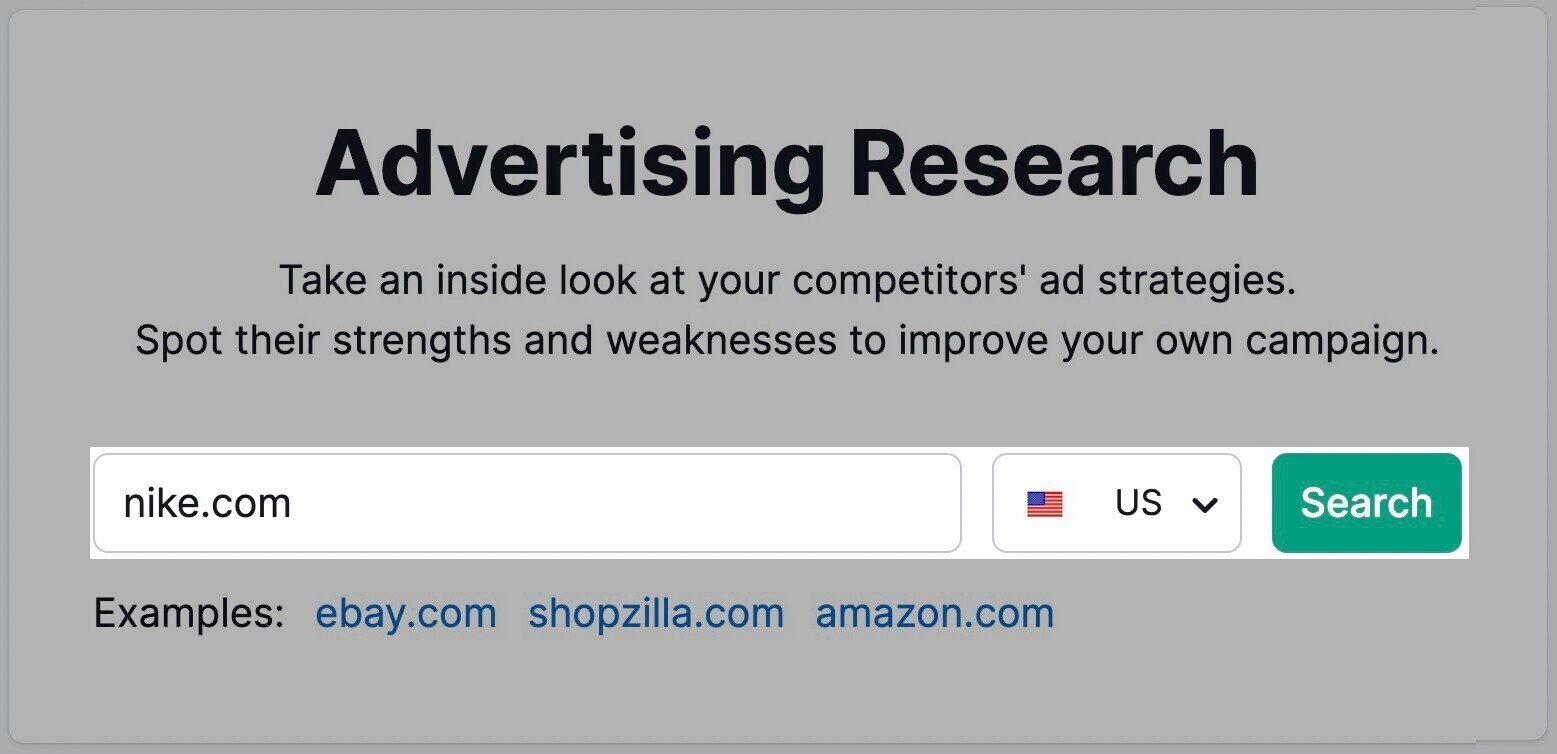
Then, go to the “Ads Copies” tab.
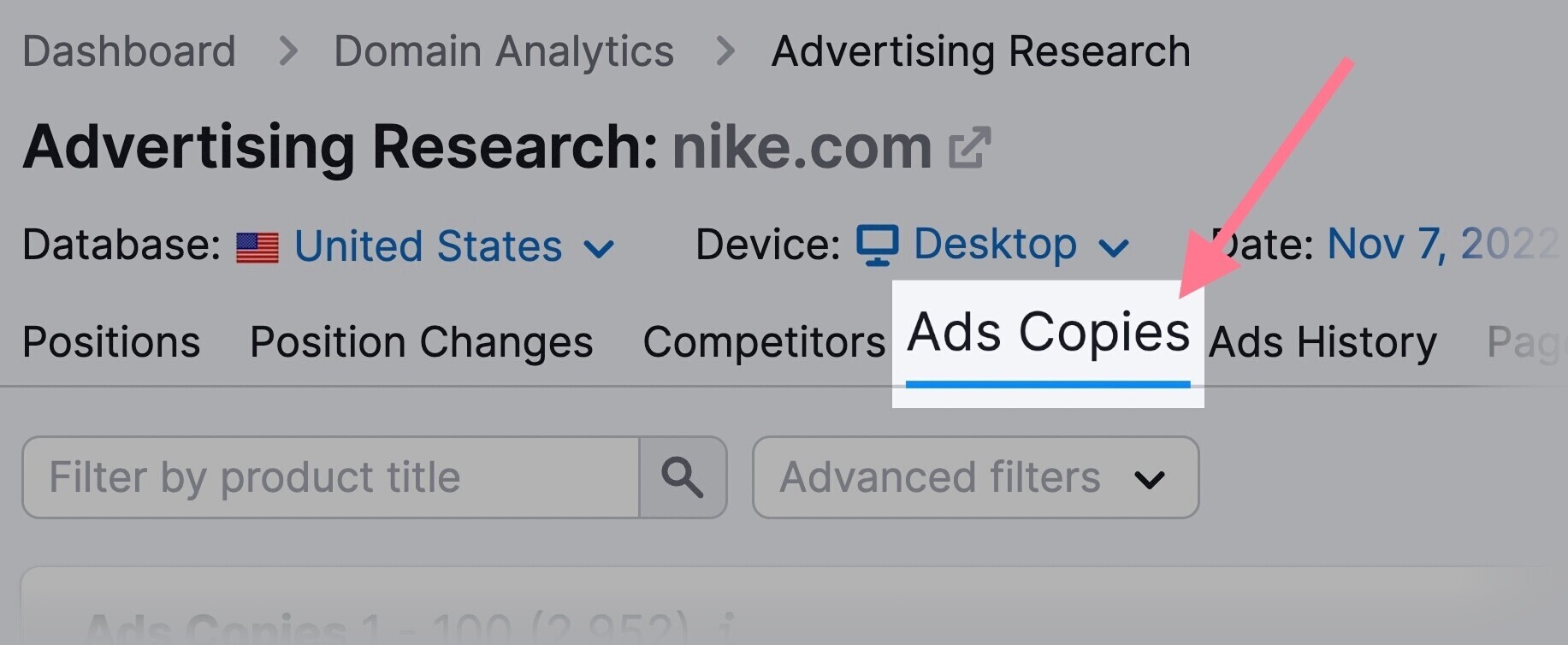
You’ll find a list of your competitor’s ads and the accompanying copy. As well as how many keywords each ad’s copy is targeting.
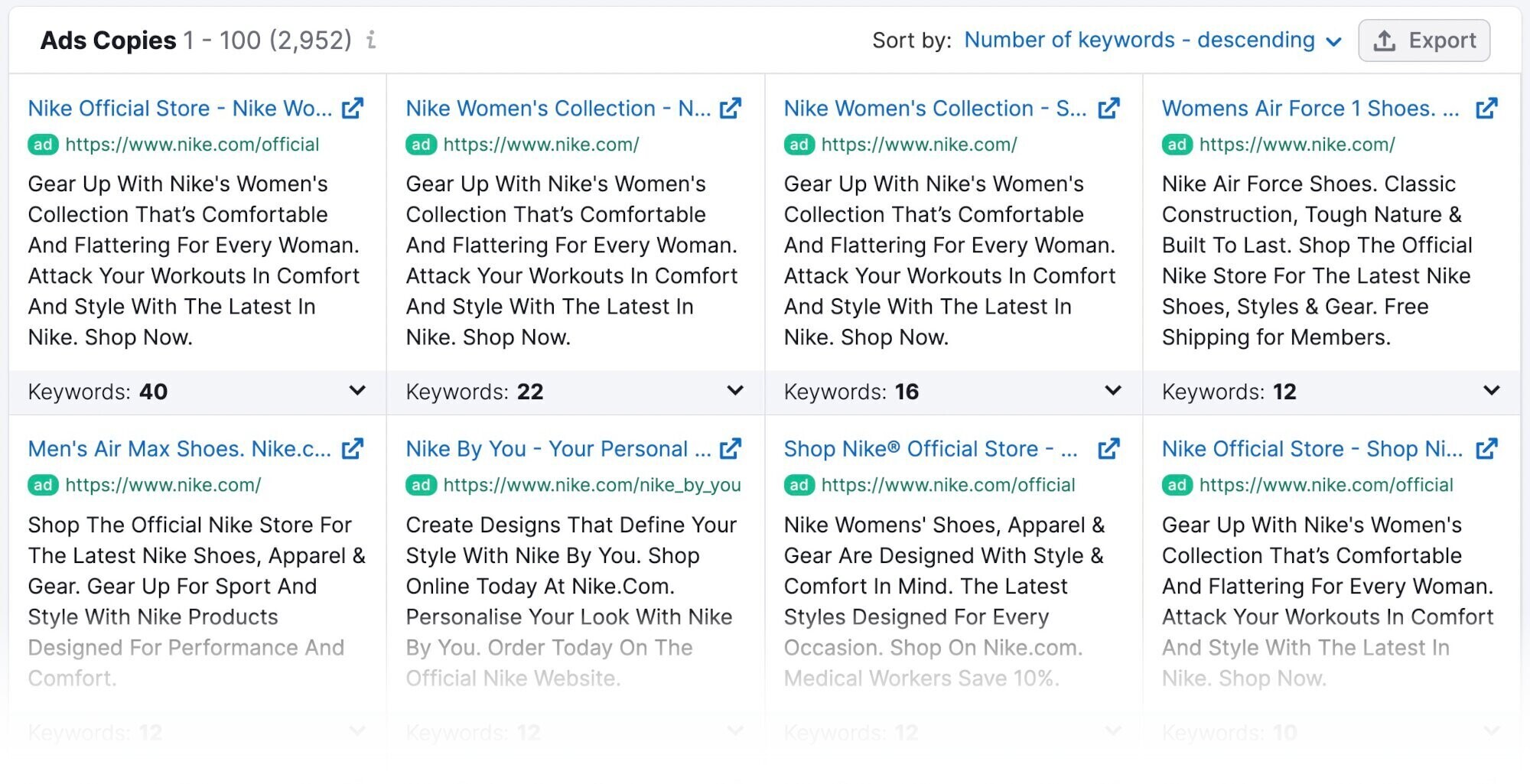
Study your competitors’ ads to see what tactics they’re using. Then determine how you can stand out.
2. Find & Bid on Long-Tail Keywords
Long-tail keywords have a relatively lower monthly search volume but are easier to rank for.
Here are a few examples:
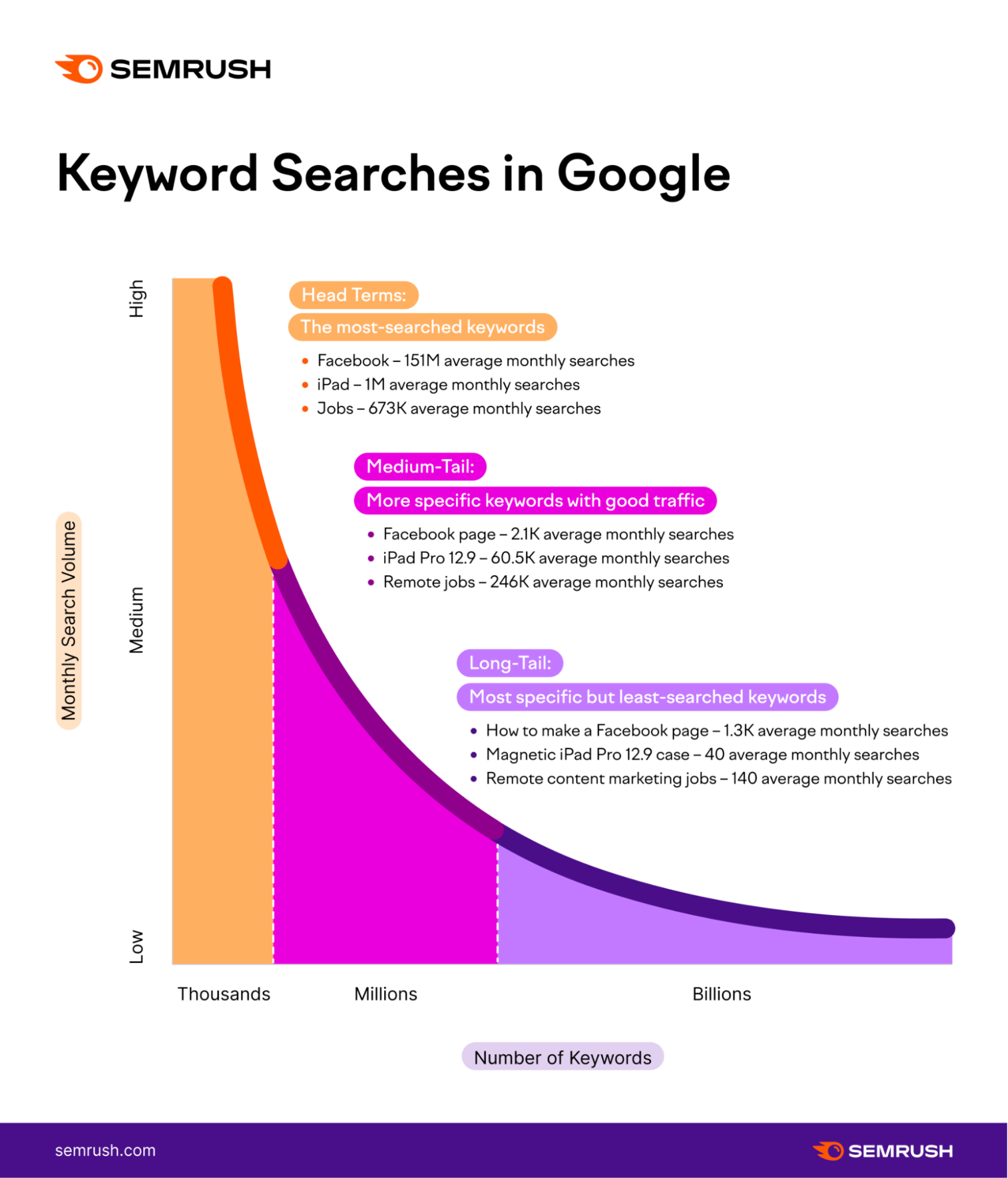
It’s easy to get caught up in targeting only high-volume keywords. But doing that will increase your CPC because everyone wants their ads to rank for those high-volume keywords.
While long-tail keywords have lower search volumes than “money keywords,” there are two main benefits to targeting them:
- They have lower competition. If fewer advertisers are bidding on a term, it will have a lower CPC.
- They typically have higher conversion rates than broader terms. This can help you benefit from an increased return on ad spend (ROAS).
Combine multiple long-tail keywords in relevant ad groups, and you could see significant increases in ad relevance.
That’s not to say you should never target competitive, high-volume keywords. You should target competitive keywords that are highly relevant to your product. But that can increase your CPC fast. Making your ads way more expensive.
Which is why we recommend diversifying your PPC strategy by targeting keywords with both high and low volumes and competition levels.
If you’re looking for additional keywords to work into your campaigns, use the Keyword Magic Tool to find long-tail keywords that can help your ads convert.
First, look up the keyword you want to target. Let’s do “hiking shoes” again.

Then, click “Advanced filters” and set “Word count” to two or three.
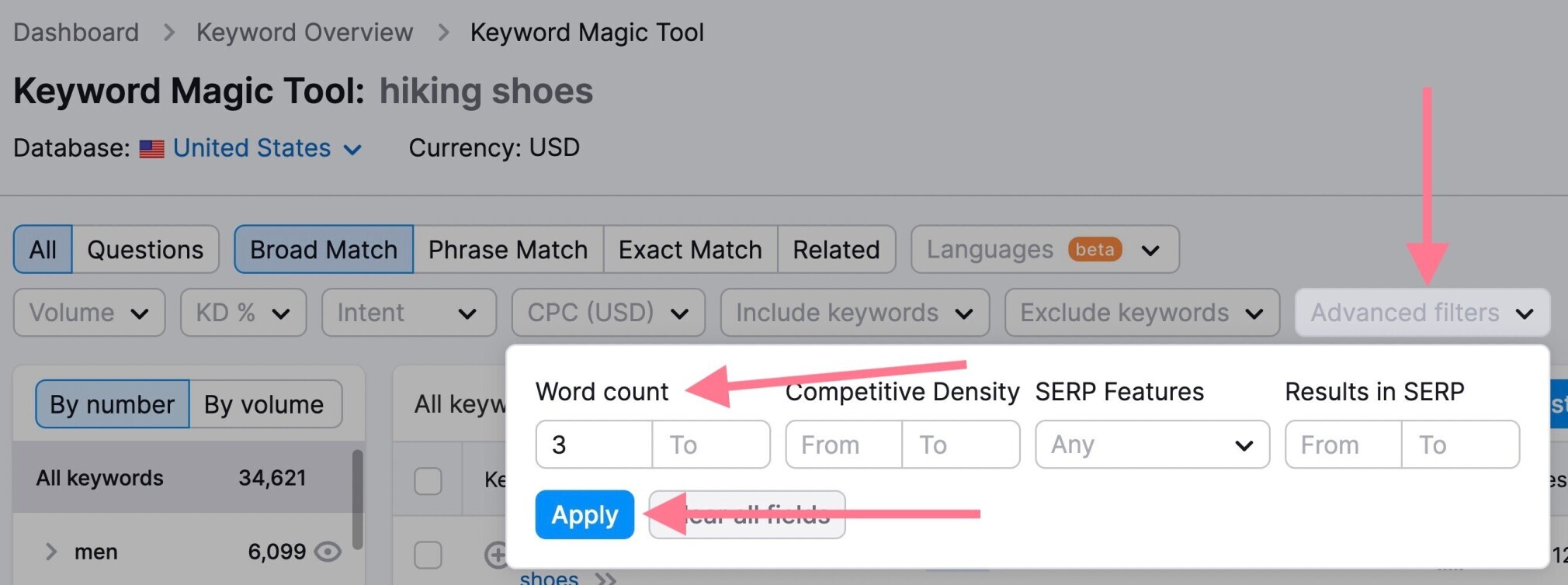
That should pull up some long-tail keywords related to your target keyword.
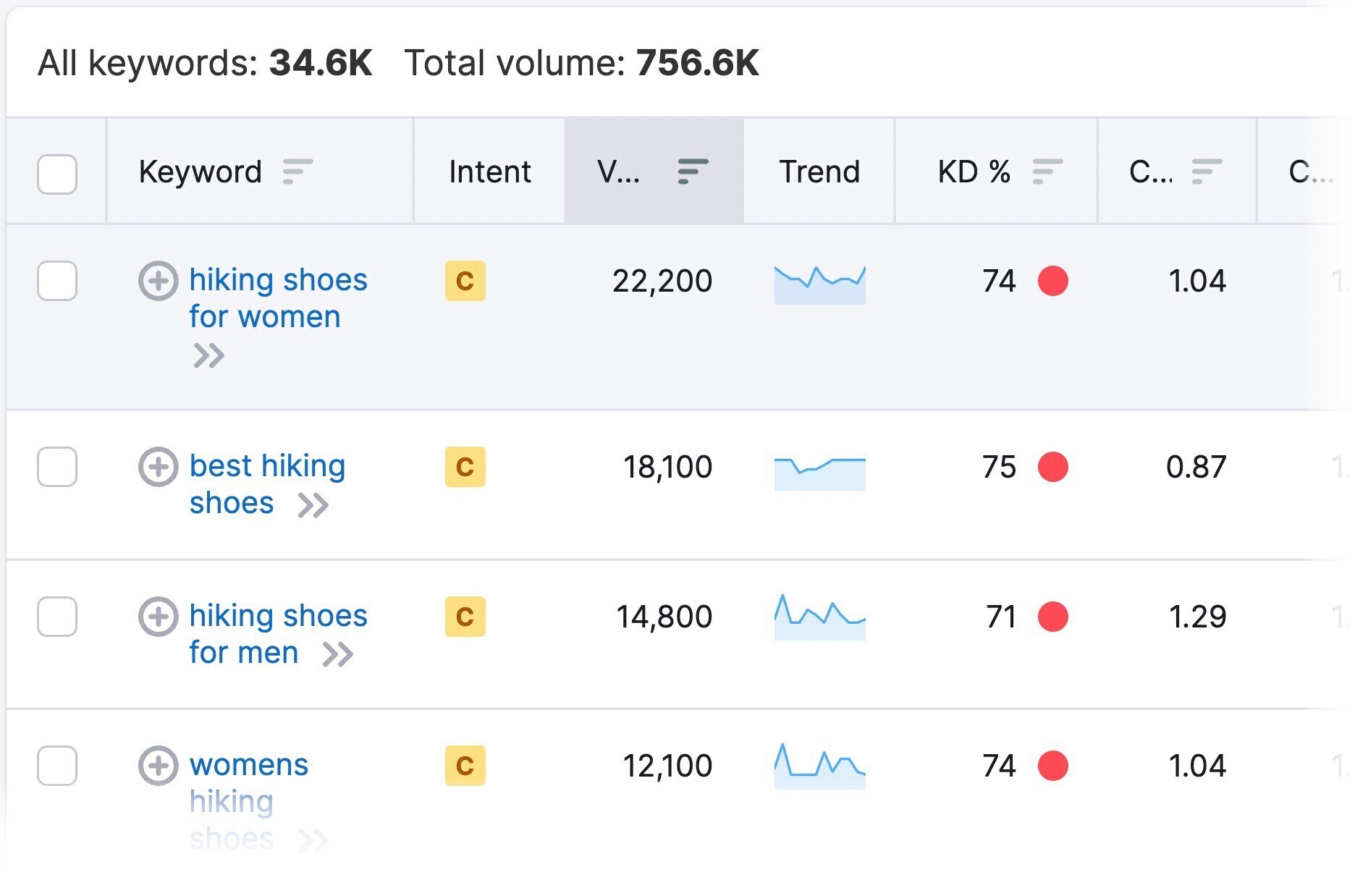
You can also select the “Questions” keyword type to get all related question keywords.
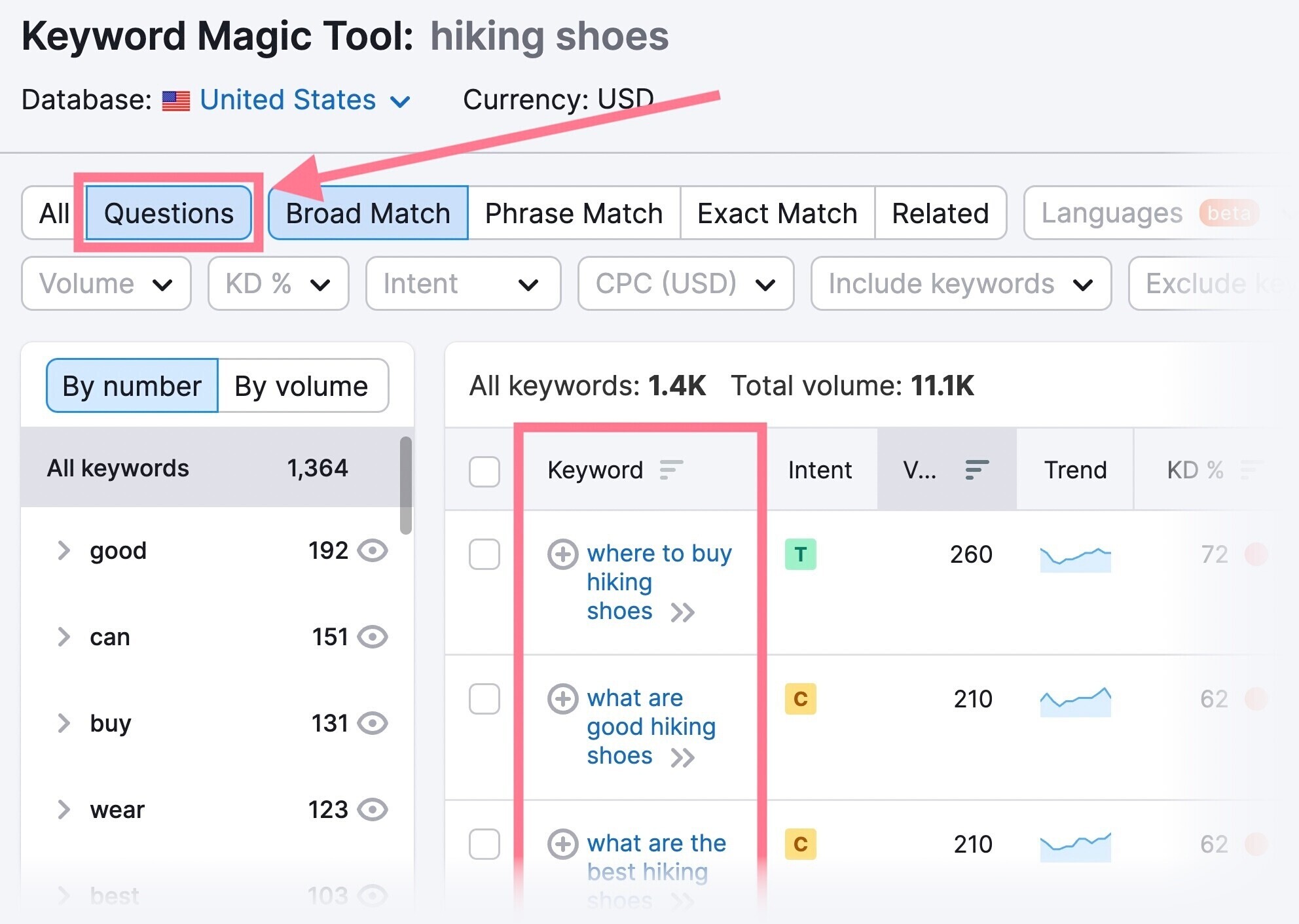
To learn more, read our in-depth guide on the benefits of targeting long-tail keywords.
3. Use Negative Keywords Effectively
Negative keywords are terms you exclude from search campaigns.
Using them can reduce your CPC. Because you won’t be bidding on irrelevant keywords. Or competitive, generic terms.
And even if you happened to rank your ad with an irrelevant keyword, you may not see the results you hoped for.
Because your Quality Score won’t be very high if your ad doesn’t match search intent. Which means your CTR probably won’t be very high, either. And a low Quality Score can increase CPC.
You can add negative keywords to ad groups, your larger campaign, or your entire account.
Start by logging into Google Ads. Then, click “Keywords” and then “Negative keywords” in the sidebar navigation.
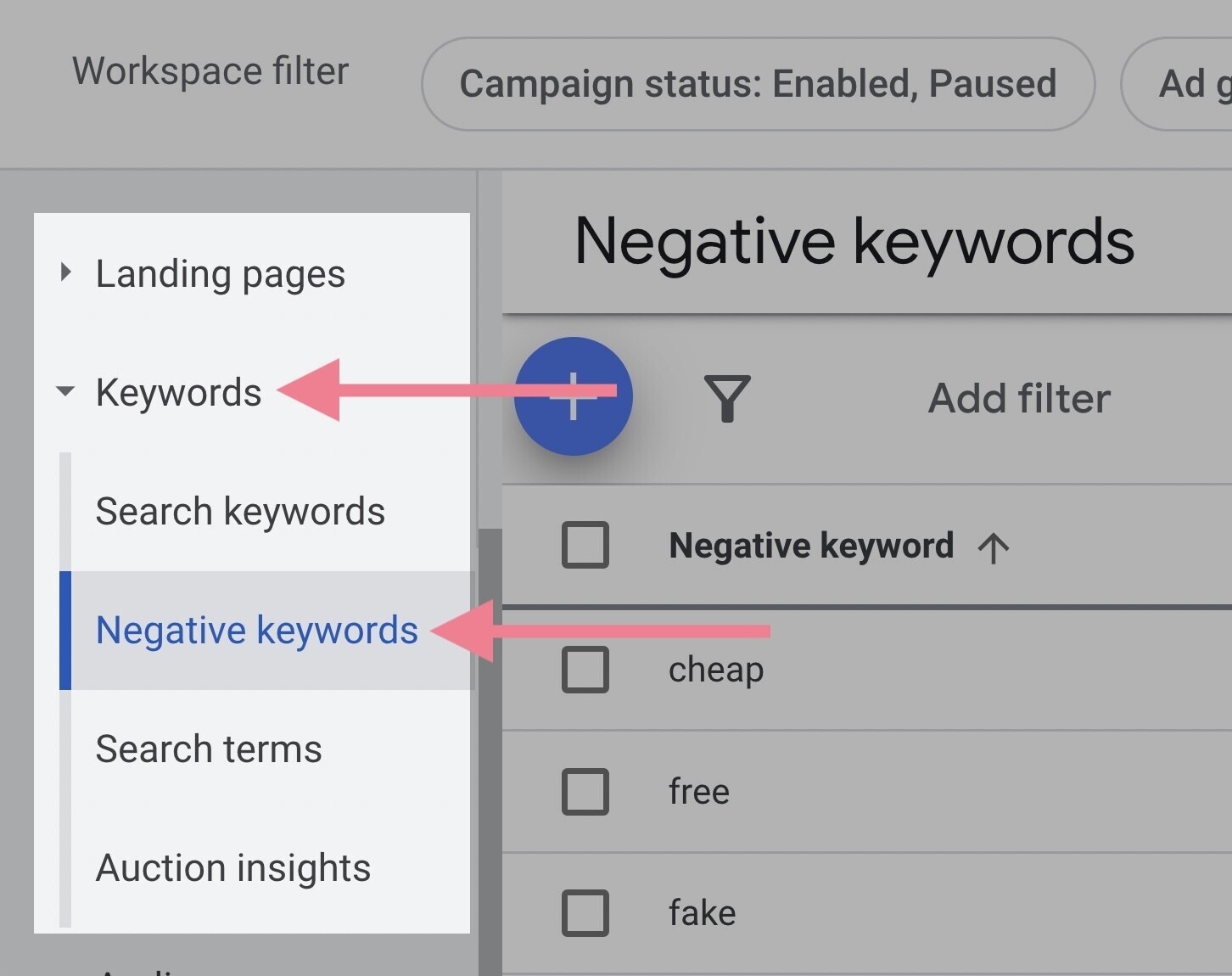
You’ll see a round blue button with a plus sign on it right next to the sidebar. Click on that to pull up a menu where you can add negative keywords.
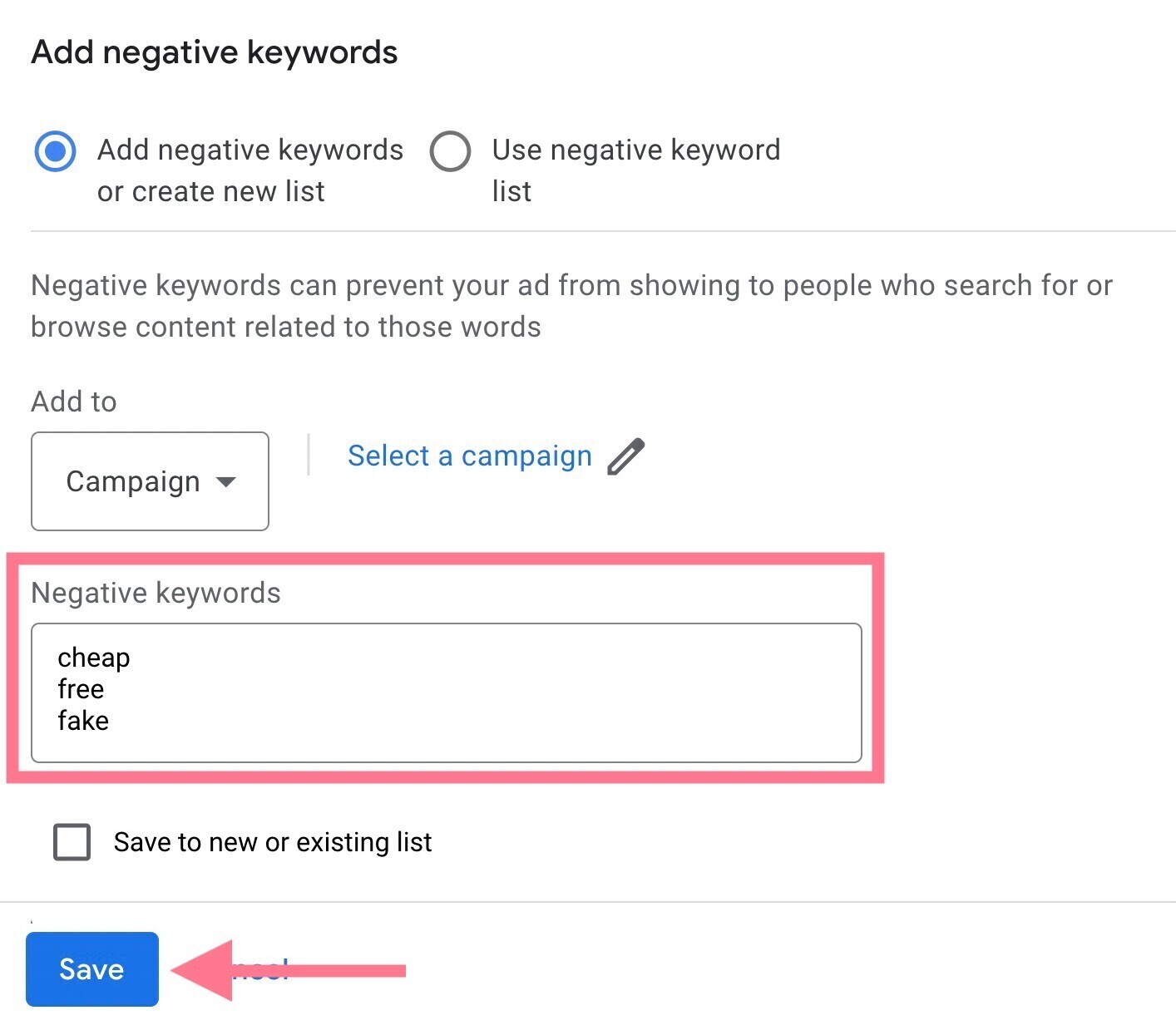
In the example above, these negative keywords would prevent your ads from showing for search queries that included “cheap,” “free,” or “fake.”
4. Use Ad Scheduling
There’s more to bidding than just keywords. By scheduling your ads, you can do two things:
- Show ads at times of the day when customers are more likely to be online
- Adjust your bid during certain times of the day
You can use these insights to put together a custom ad schedule. This tactic will help you maintain and improve your average CPC while driving more conversions from your budget.
To schedule ads, scroll down your Google Ads dashboard’s sidebar navigation. And click “+Show more,” “Ad schedule,” then “Ad schedule” again.
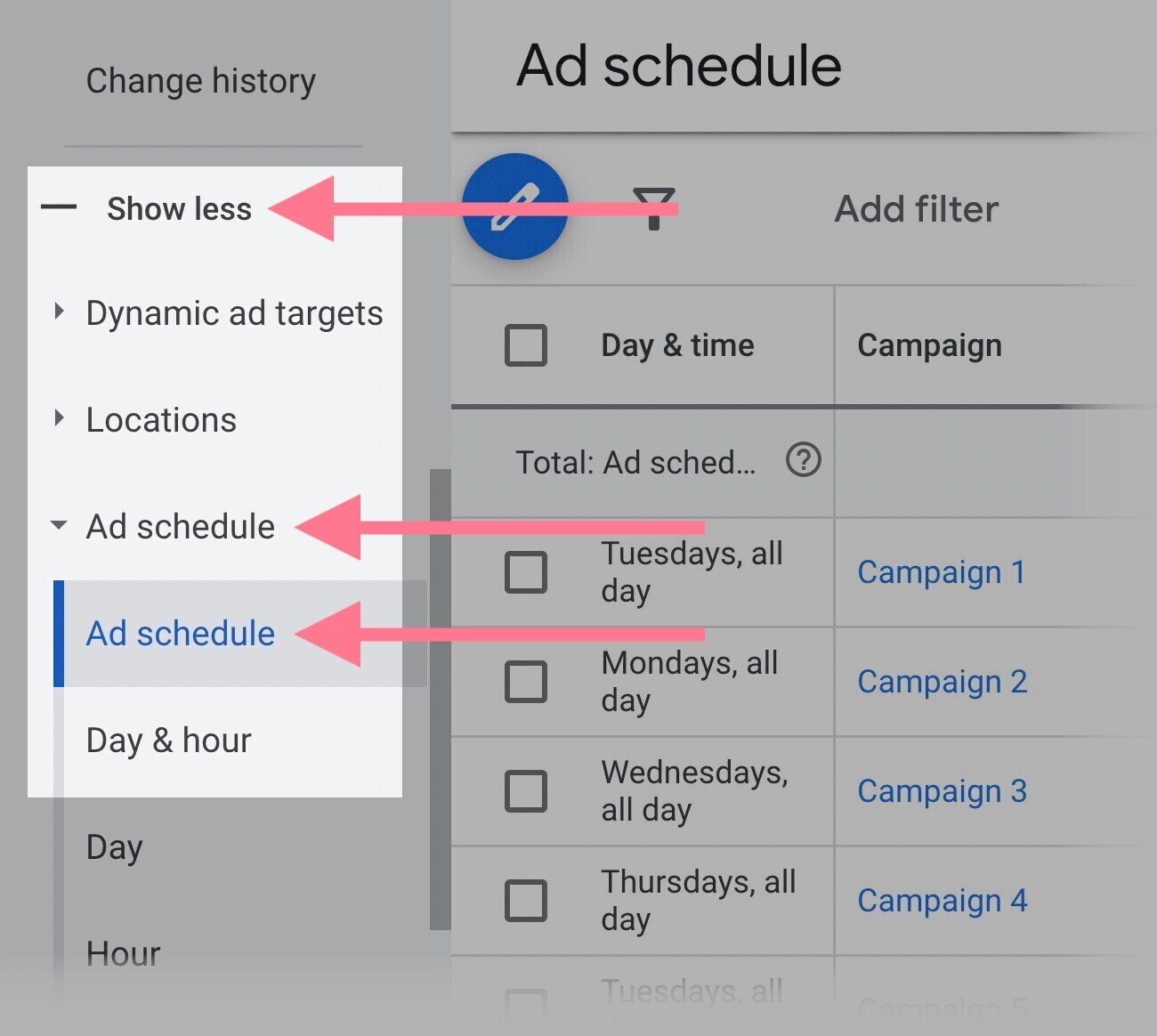
Then click on the pencil button right beside the sidebar nav. And select a campaign from the menu that pops up.
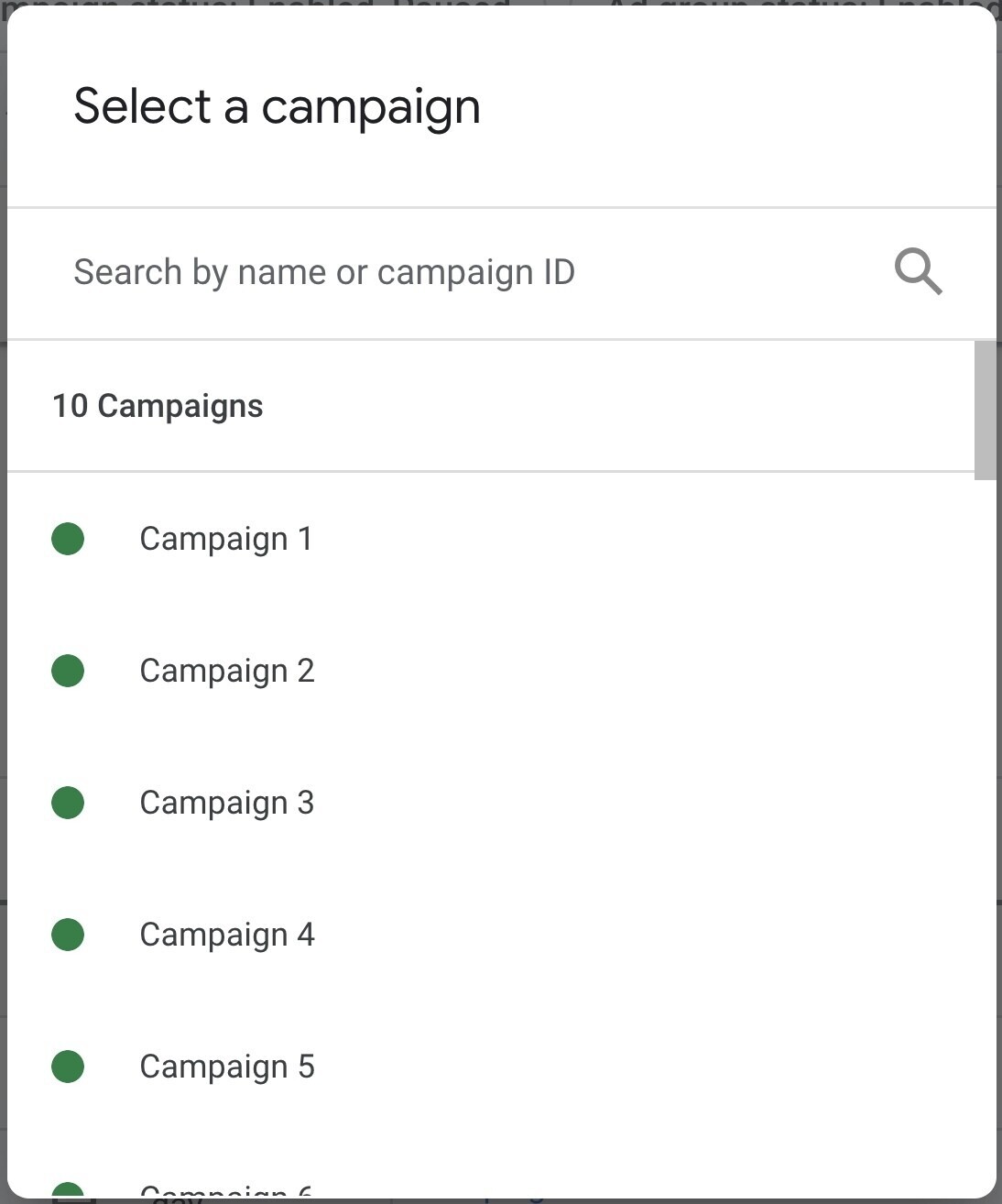
Finally, set your schedule and hit “Save.”
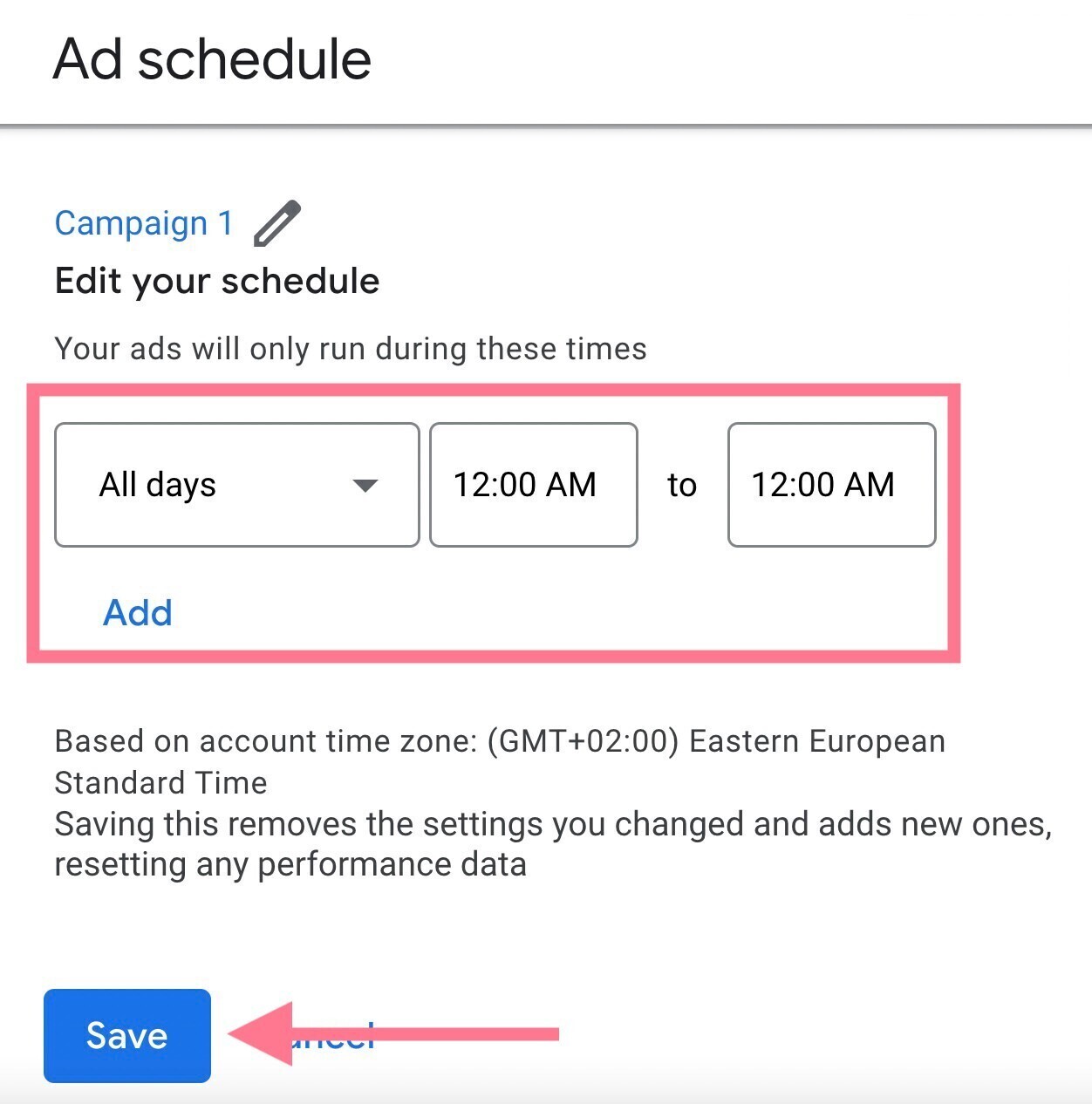
5. Use Geo-Targeting
You can also target specific countries, areas within a country, a radius around a location, or location groups. Location groups might include places of interest or your business locations.
Then, apply bid adjustments to change bids based on users’ locations. If an area has a lower conversion rate, you can adjust your strategy to maximize visibility where it makes sense.
Let’s say you want to target a specific country with your ads.
First, go into your Google Ads dashboard and click on the “Campaigns” tab in the sidebar navigation. And select the campaign that you want to set up location targeting for.
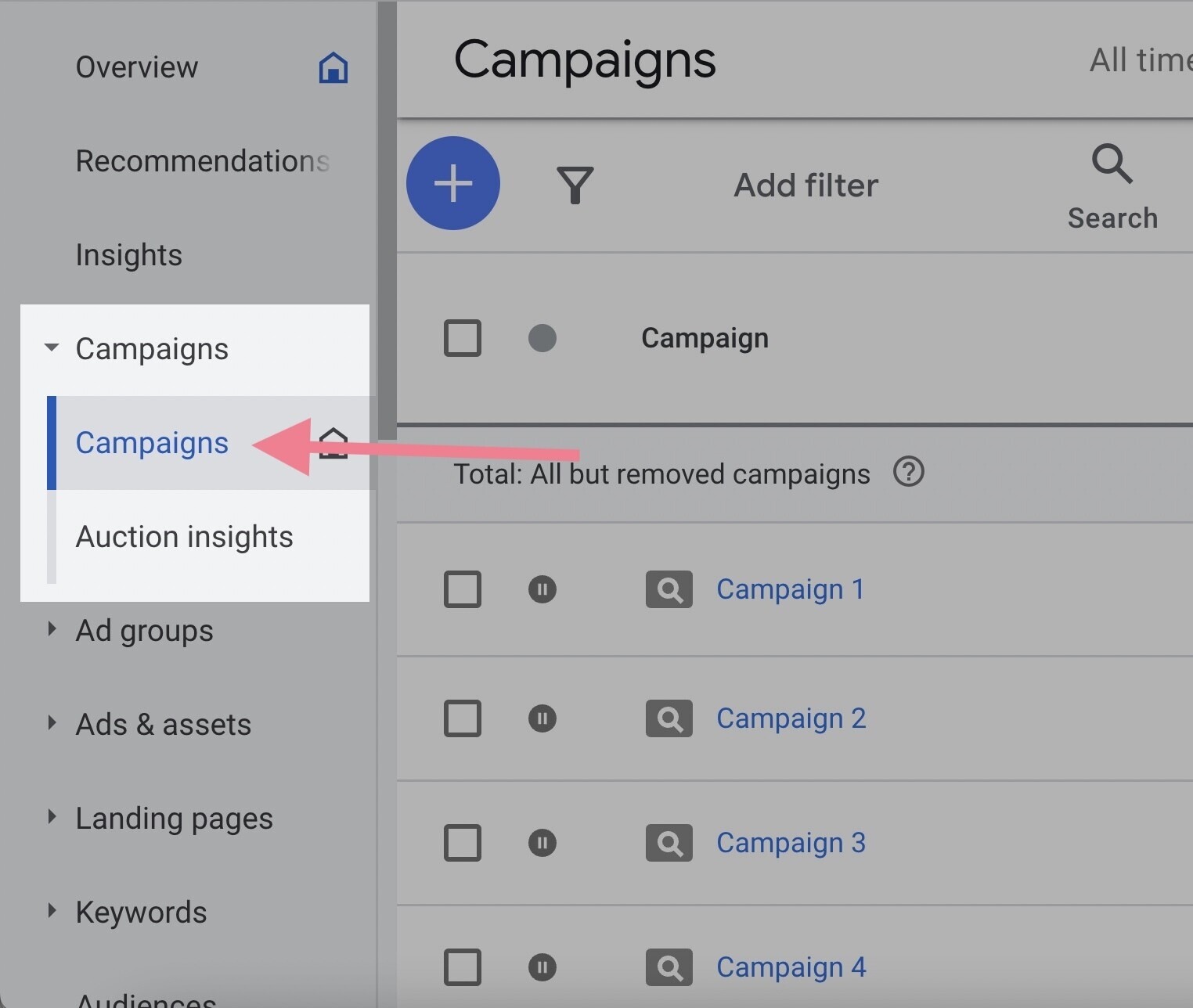
Then, click “More details” at the top of the page.
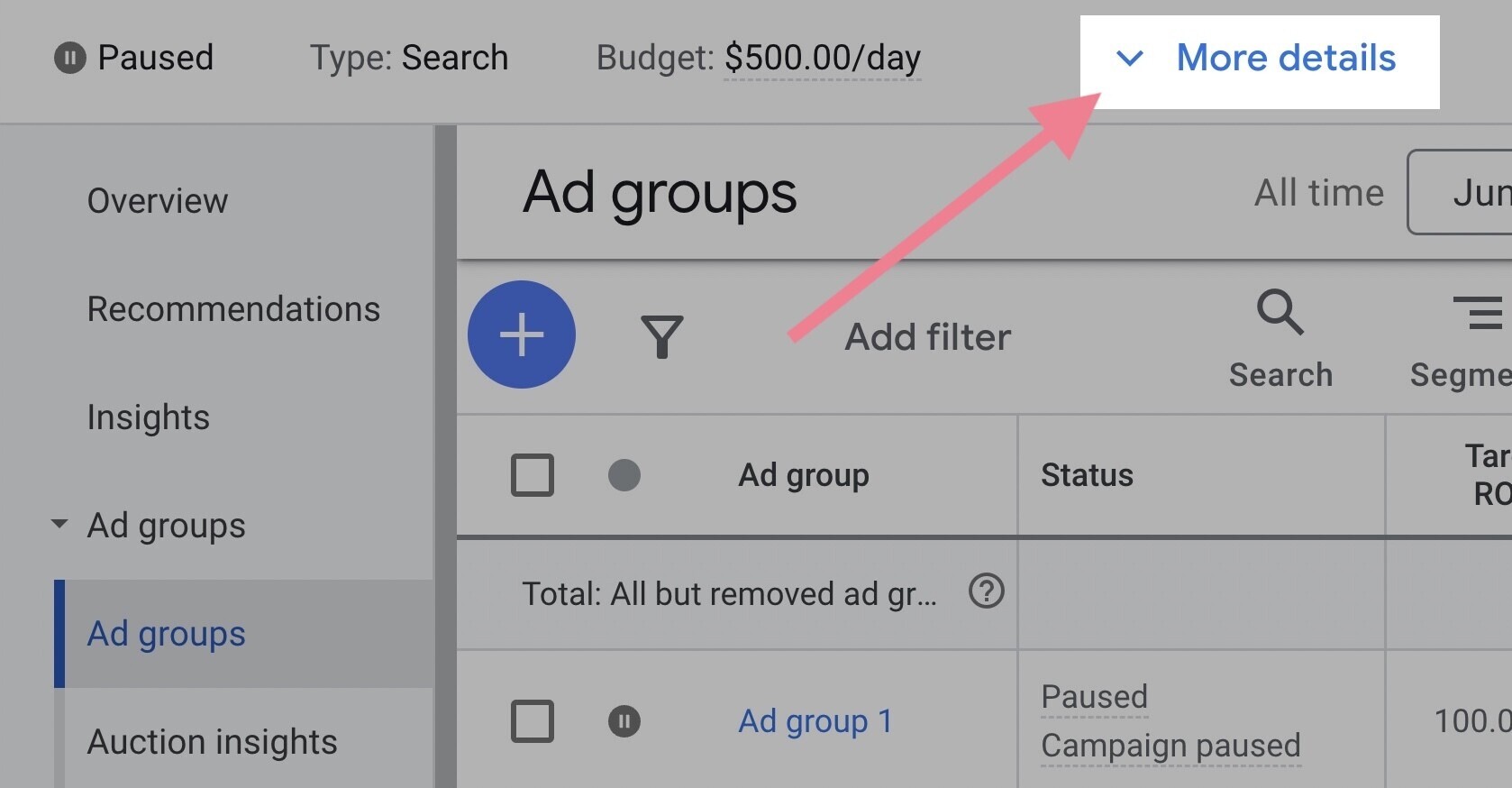
This should pull up a summary of your ad campaign. Hit the “Edit in settings” button at the top right corner of the summary page.
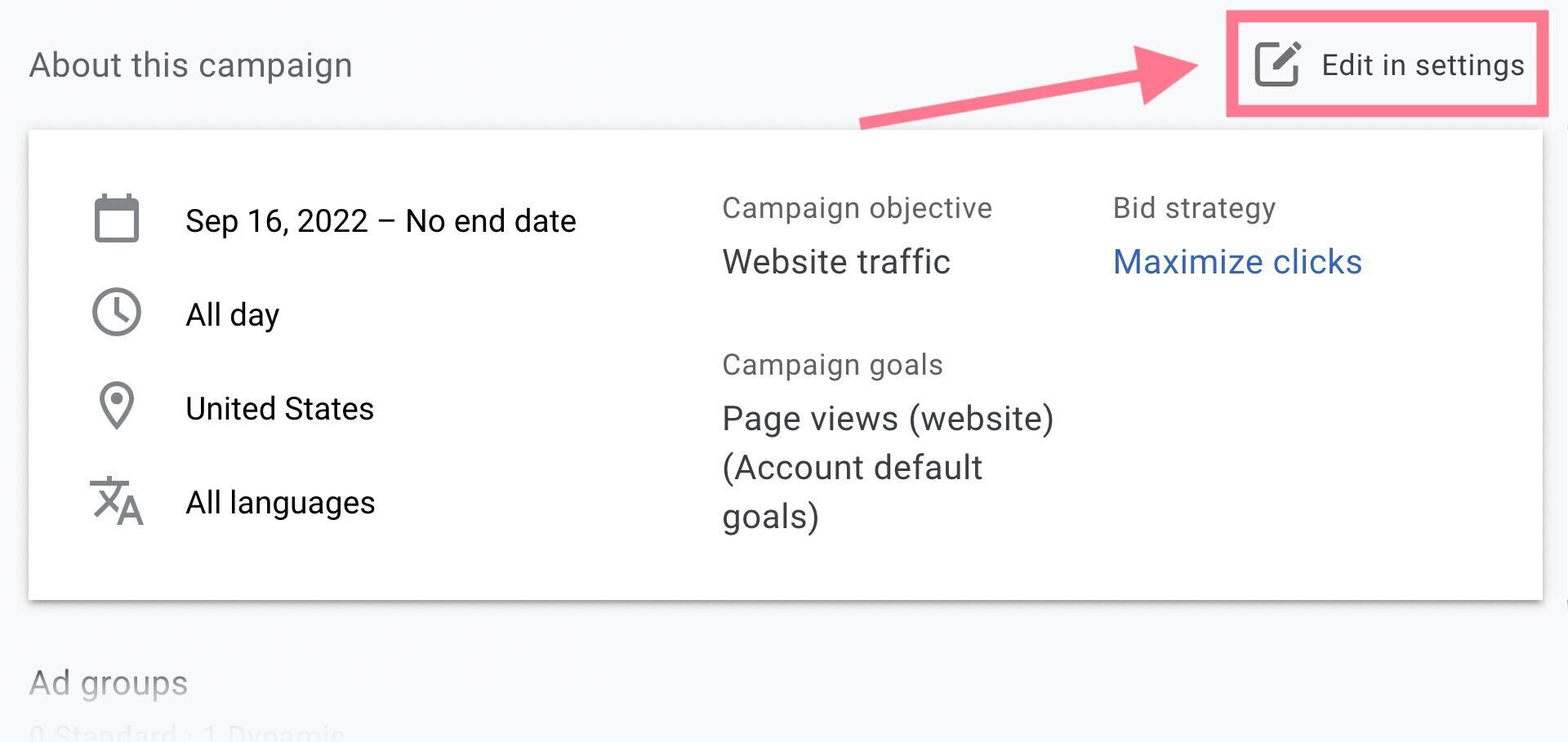
Scroll down through the different settings options until you see “Locations.” Hit the down arrow beside it.

In the menu that opens, set your target locations based on the prompts. Hit “Save,” and you’re done.
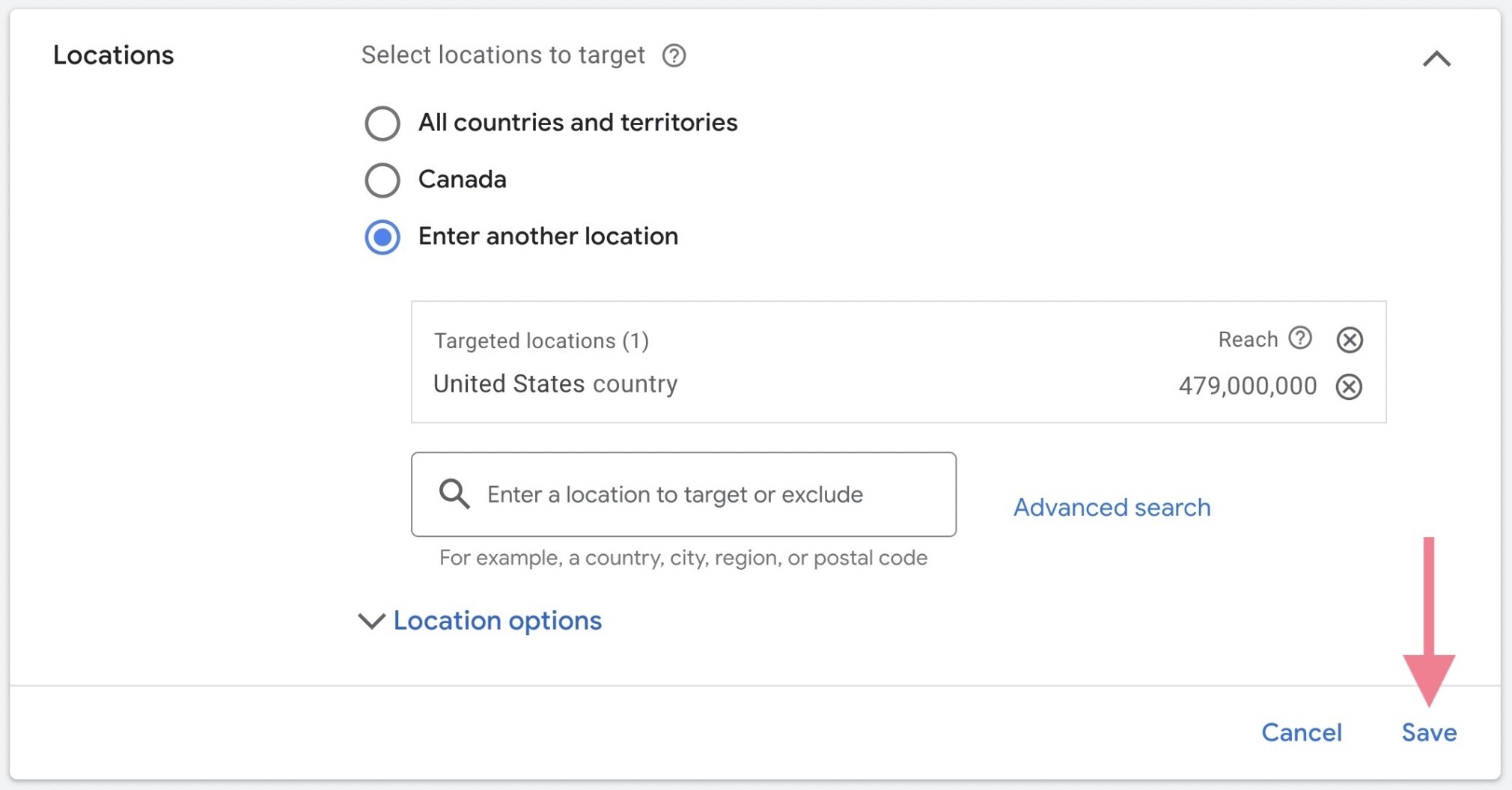
You can also target areas within a country and a radius around an area. Or you can target multiple locations with one ad.
Here’s Google’s guide on setting up different types of location targeting.
6. Use Different Keyword Match Types
Keyword match types control how targeted the search queries that trigger your ads are.
For example, you could use broad match keywords to show your ad to a wider variety of searchers. Or you could use exact match keywords if you want to target a more specific group of users.
The more targeted your keywords are (exact match), the more expensive your CPC will likely be.
To get more (or less) specific with your ads, consider adding keyword match types to your campaigns.
Common keyword match types you can use in your ad groups are:
- Broad match: Ads can show on searches related to your keyword
- “Phrase match”: Ads can show on searches that include the meaning of your keyword
- [Exact match]: Ads can show on searches that are the same meaning as your keyword
Google explains the difference below using the keyword “lawn mowing service” as an example:
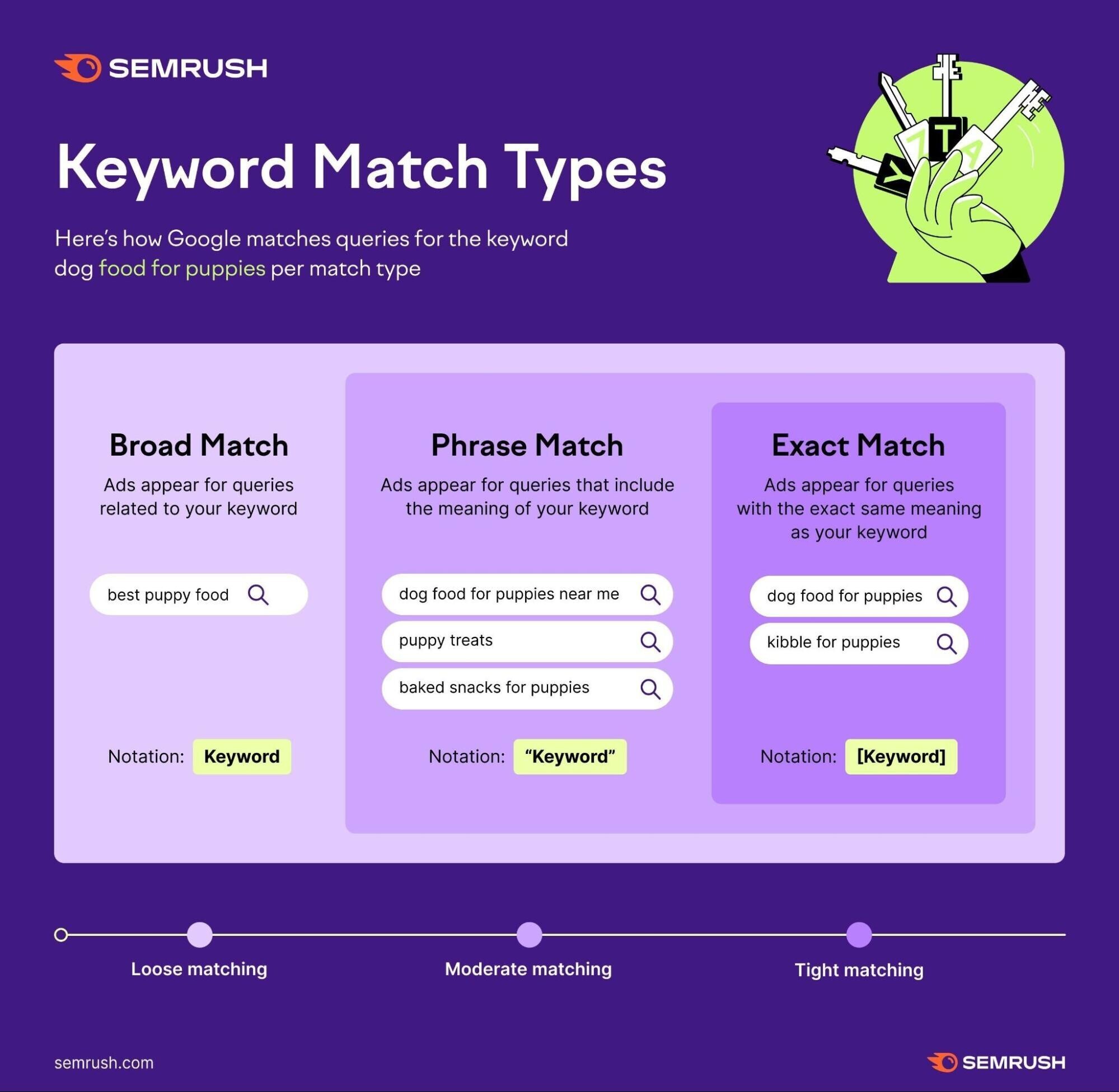
Pro tip: You can use Smart Bidding with all match types to optimize for your goals (conversions, conversion value, etc.). But it works best with broad match. Because the broader range of searches lets Smart Bidding learn what strategies work best for you.
7. Use Device Adjustments
In addition to adjusting bids based on location or time of day, you can increase or decrease your max CPC across mobile, tablet, and desktop devices.
Start by researching how your customers behave on each device through Google Ads. For example, mobile devices may attract more clicks and impressions. But you may find that searchers are just browsing rather than converting.
First, hit the “+Show more” button in the sidebar navigation. Then click on “Devices.”
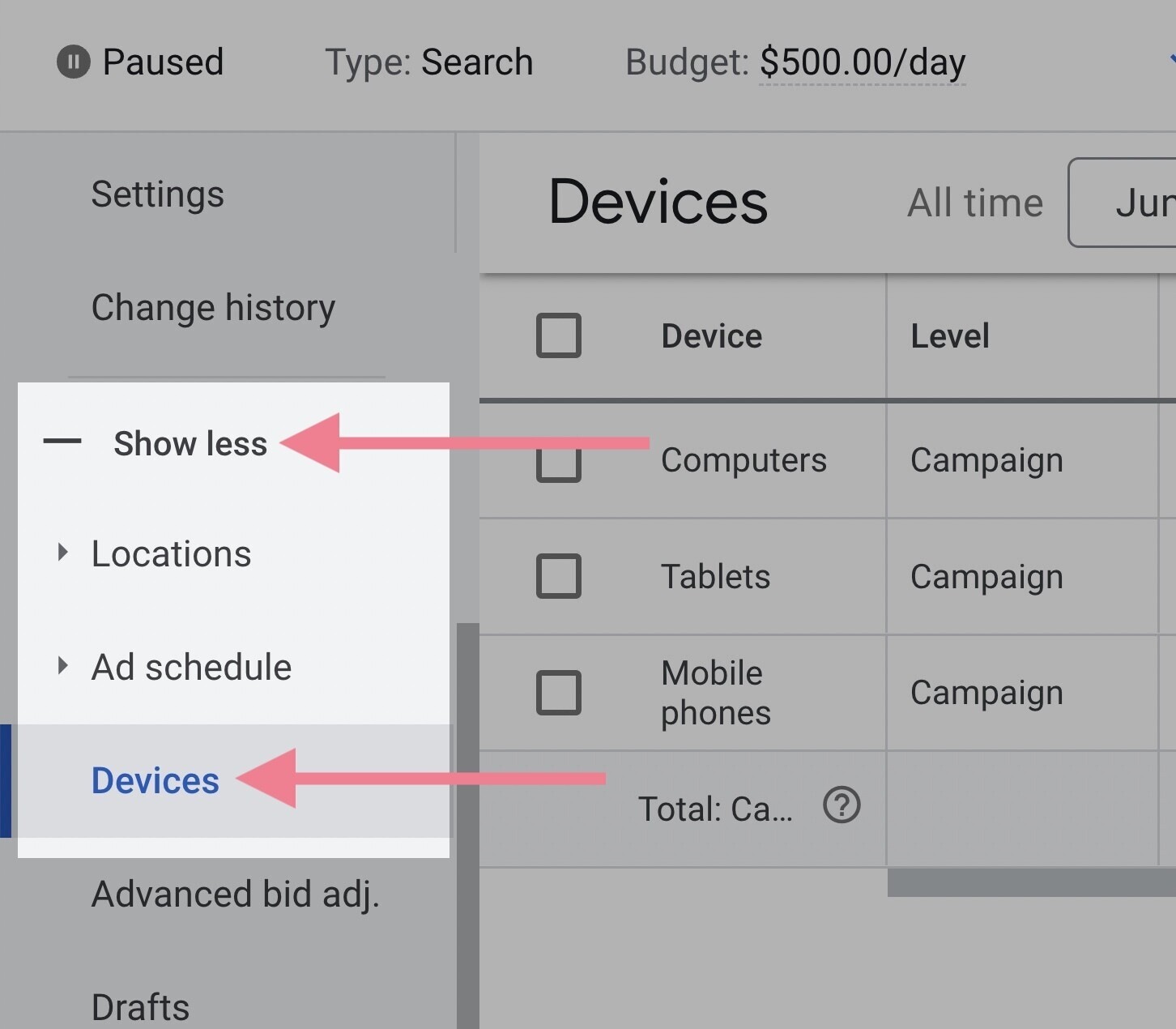
You should see a report giving you more data on your ad performance per device.
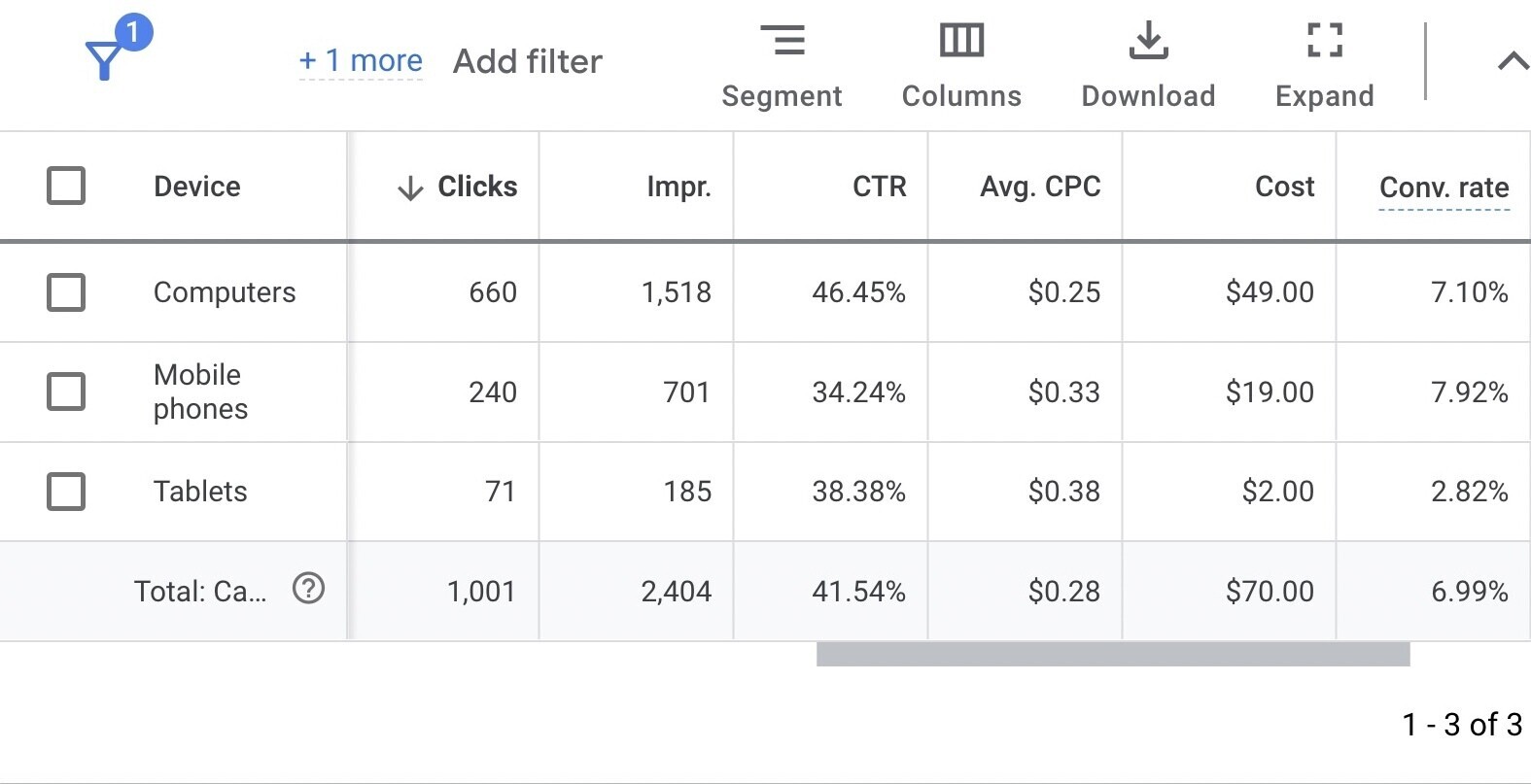
In this instance, you could apply a negative bid adjustment to reduce your CPC on mobile. Then you could apply a positive bid adjustment on desktop.
Pro tip: Enhanced CPC does this for you automatically.
Be sure to carefully dig into your data to make informed decisions about how your audience behaves.
Learn More About Paid Search
Learning how cost per click works is a great start to creating a well-developed paid search strategy.
Want to keep learning? Here are some recommended resources:

